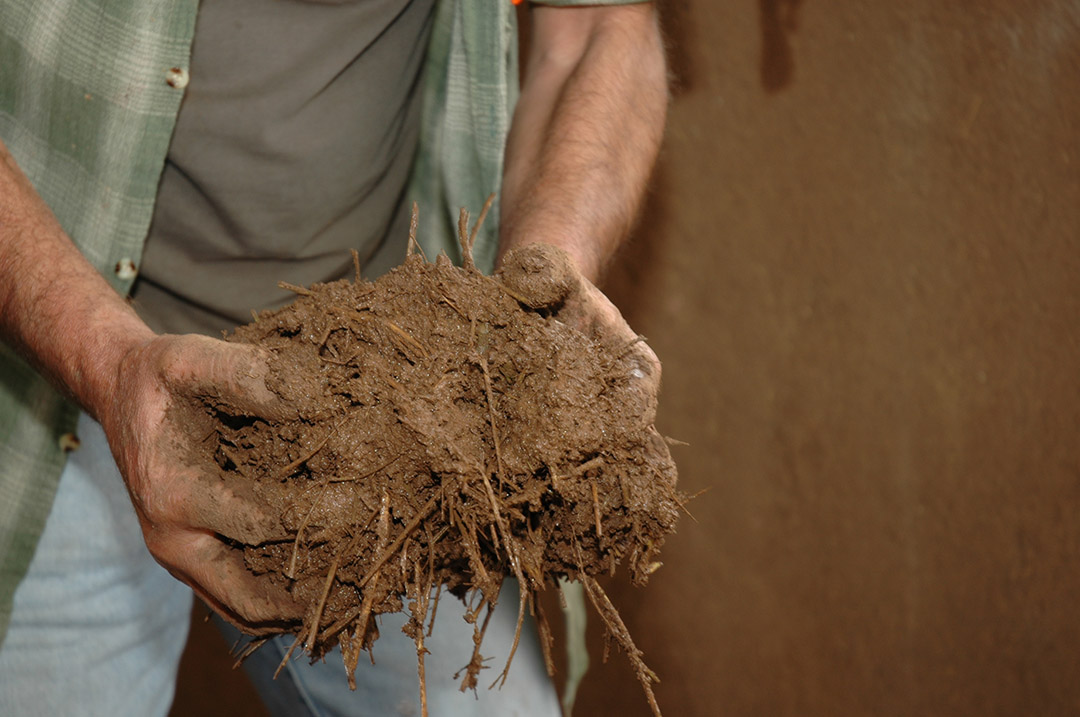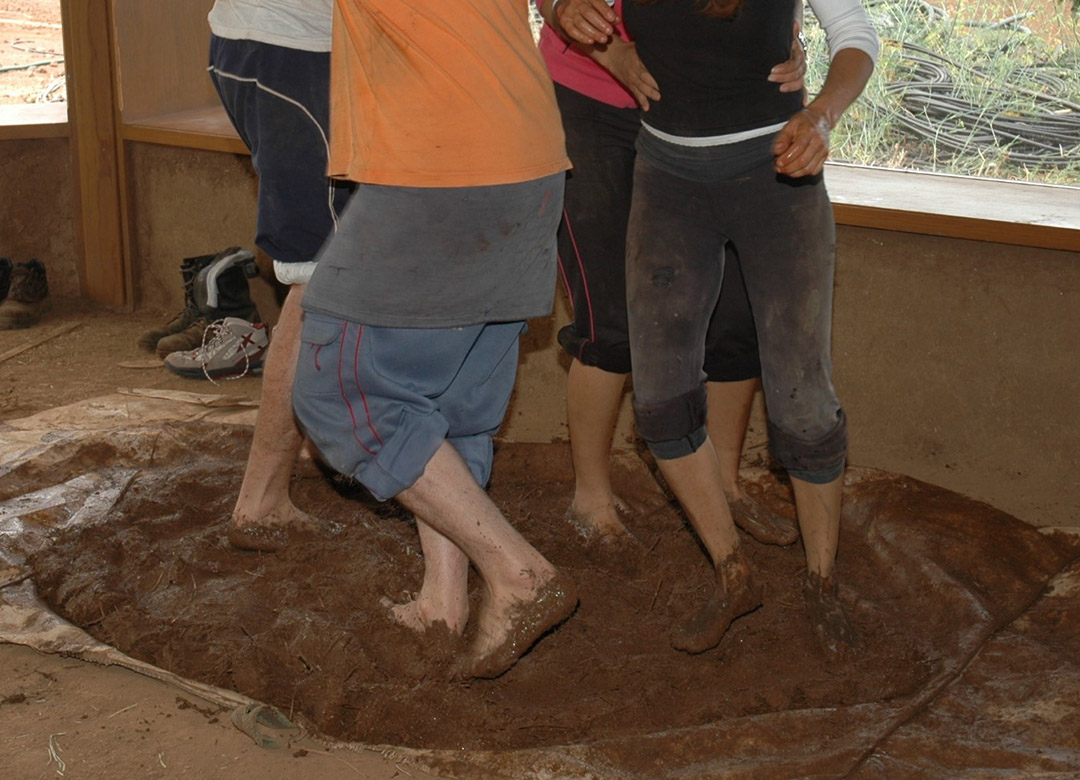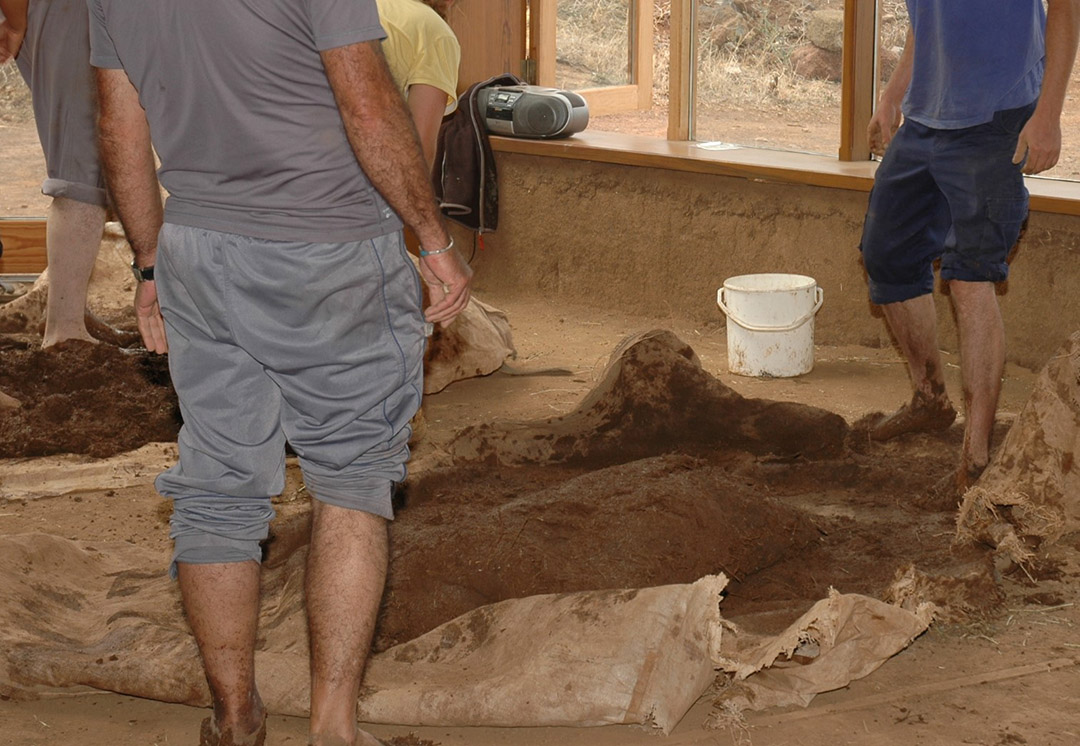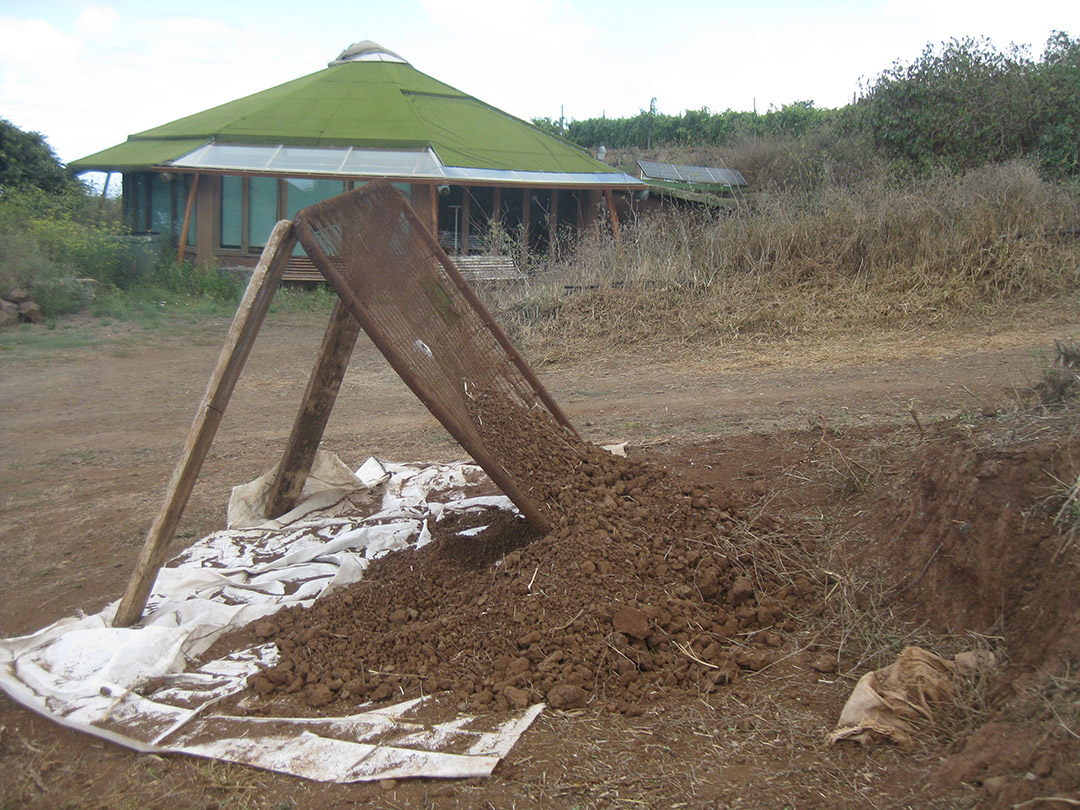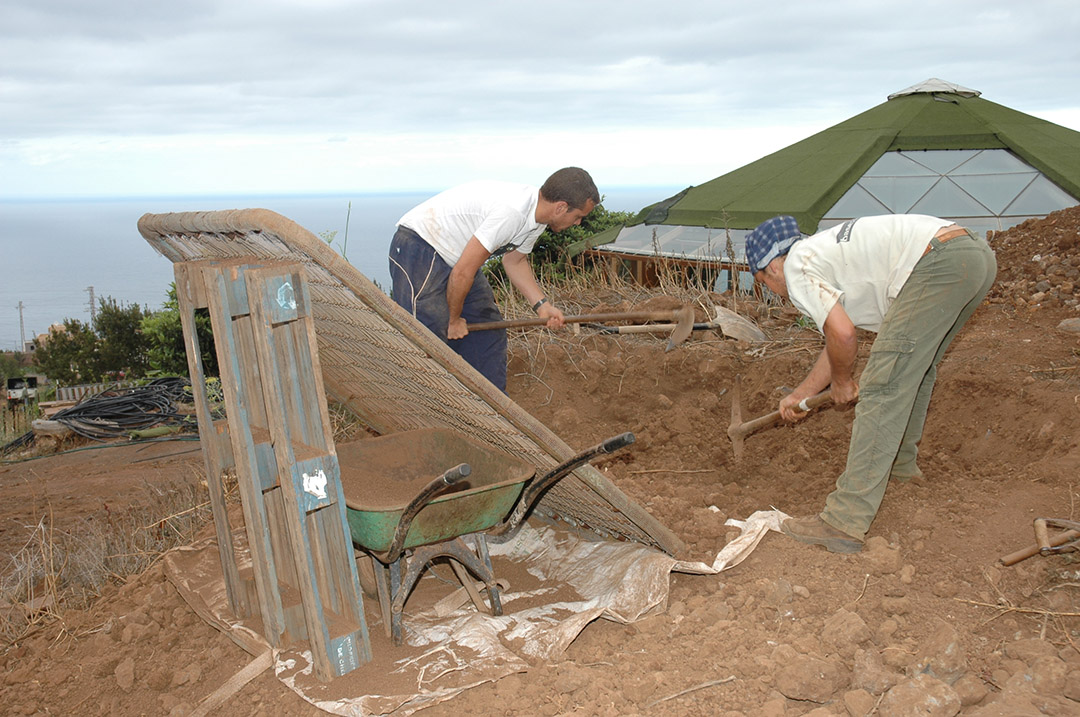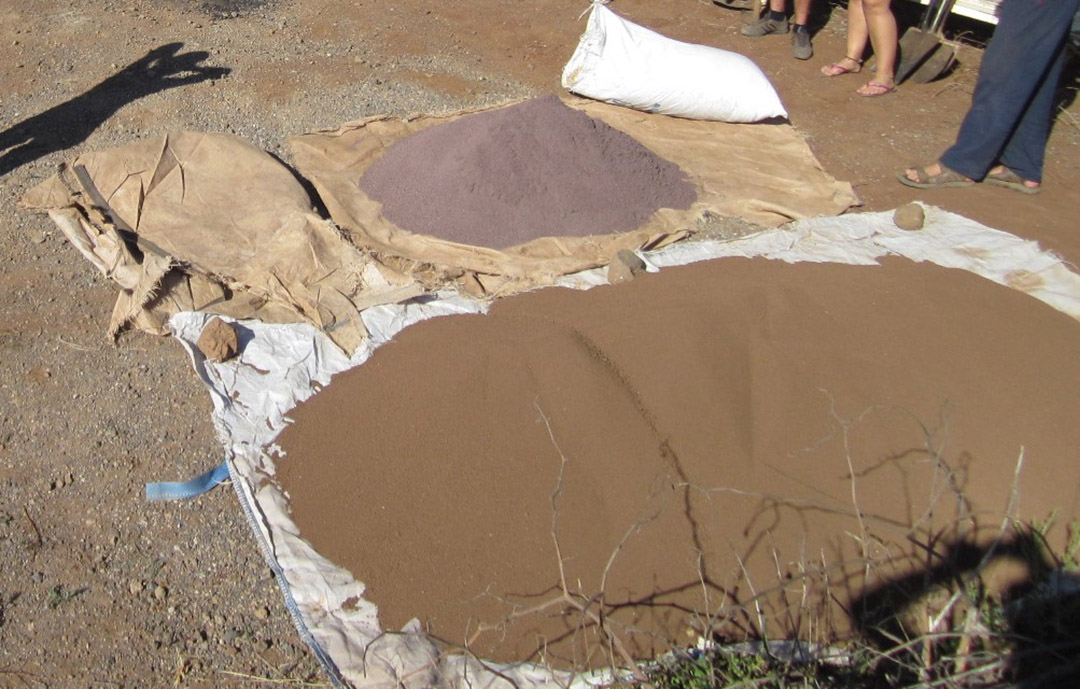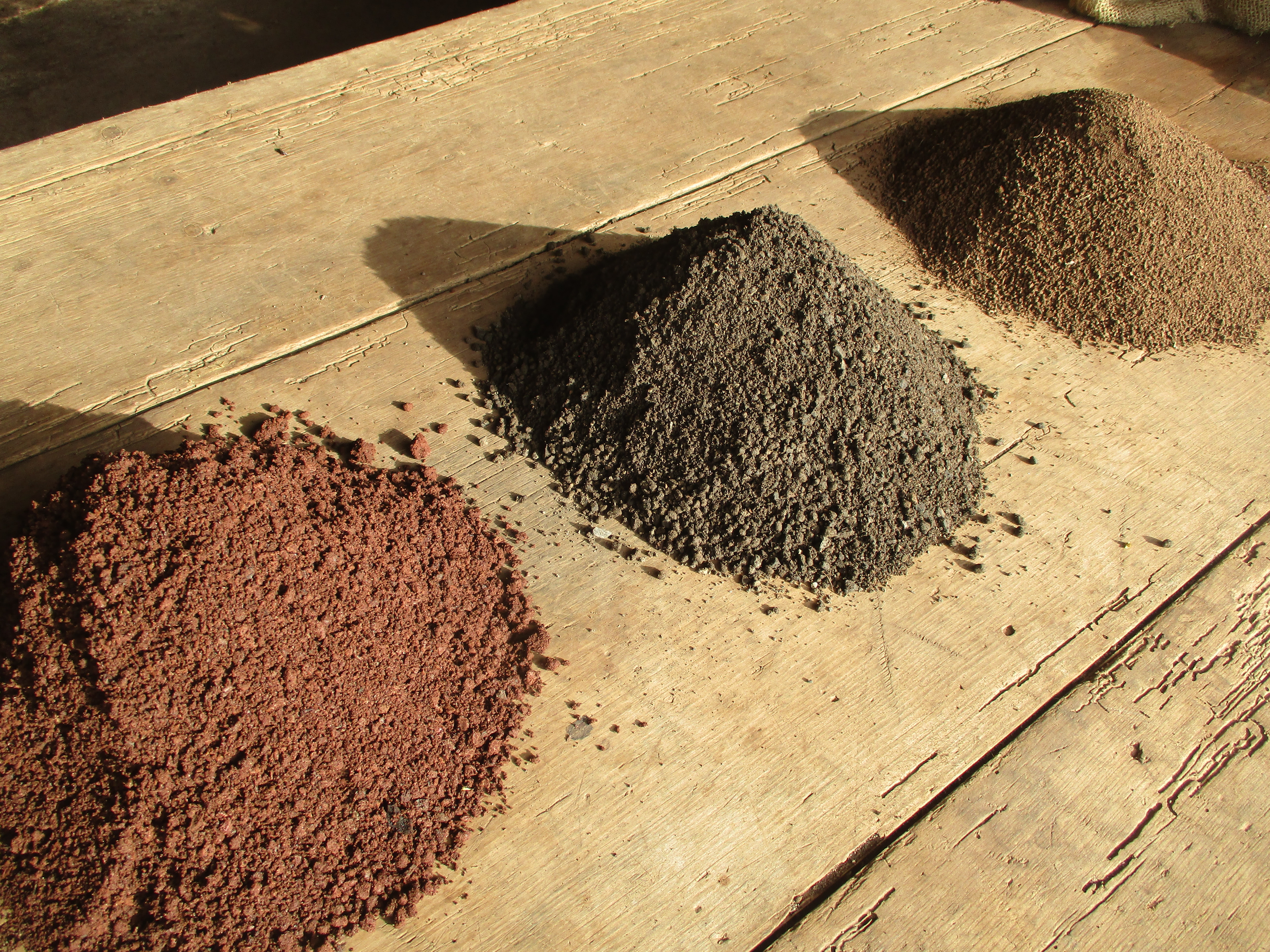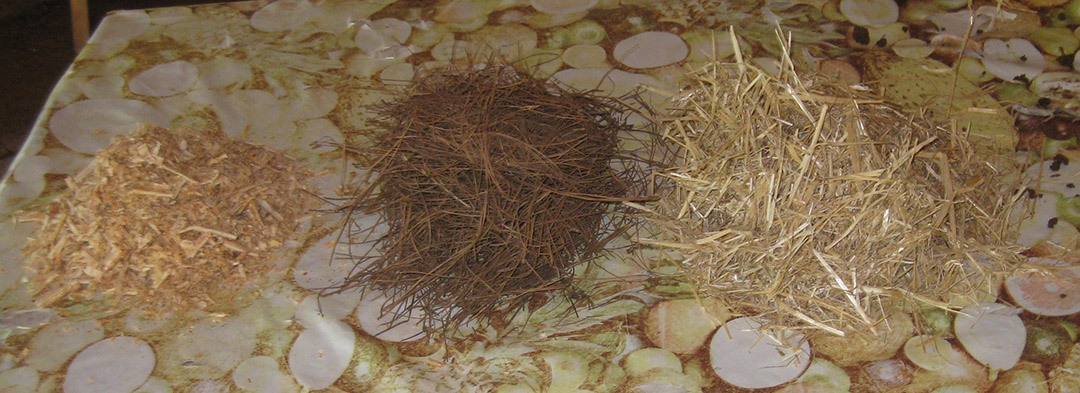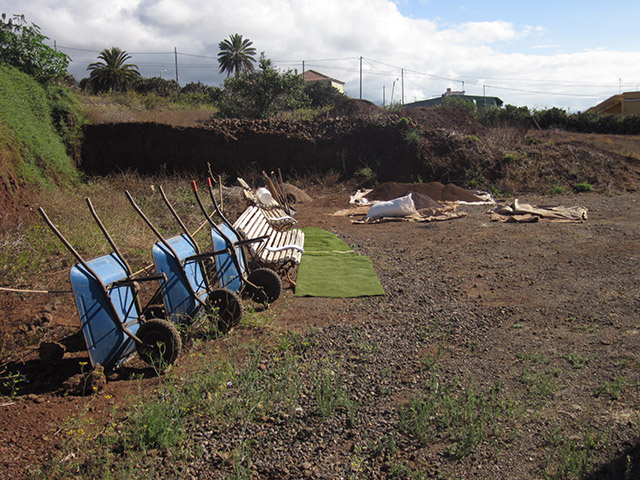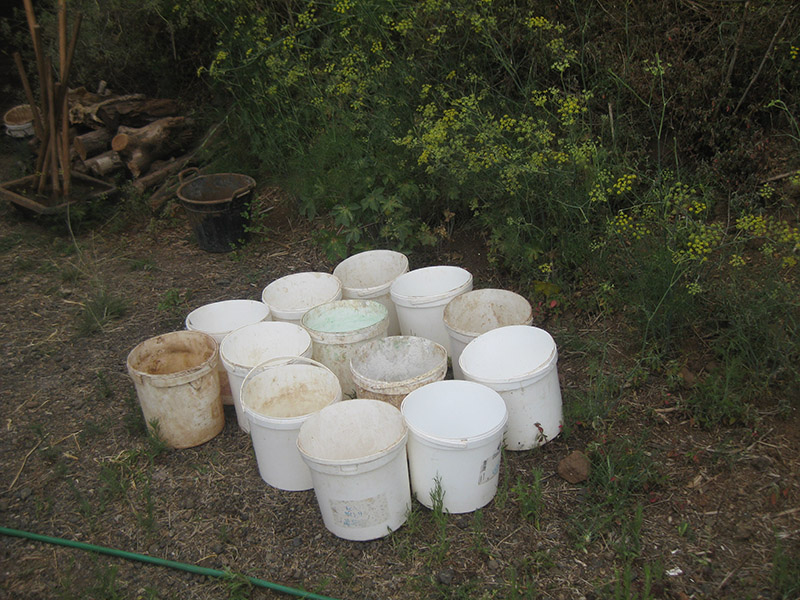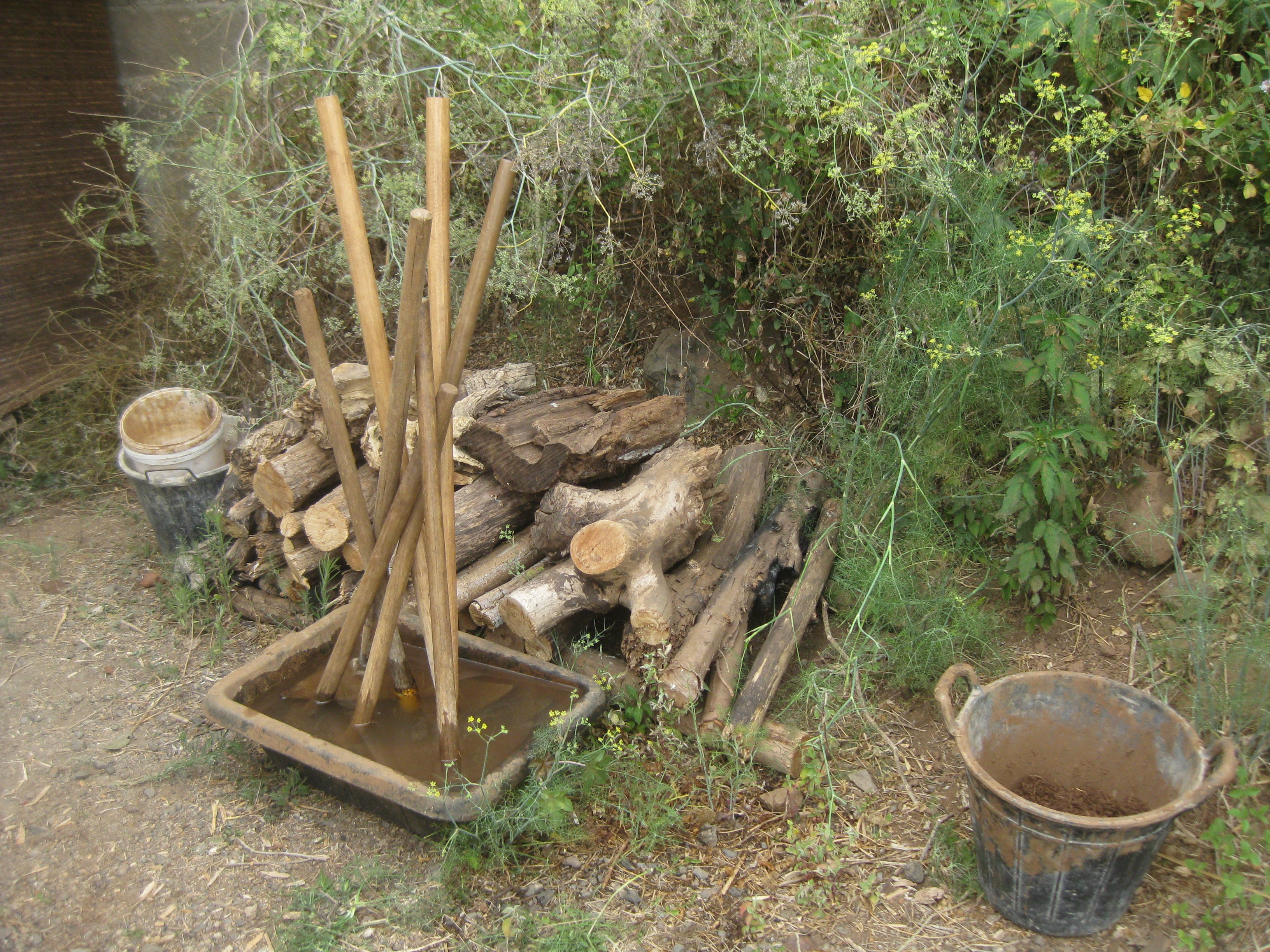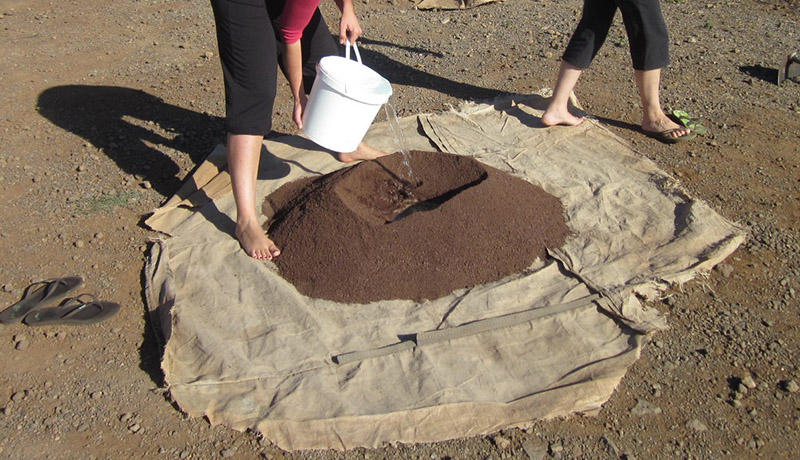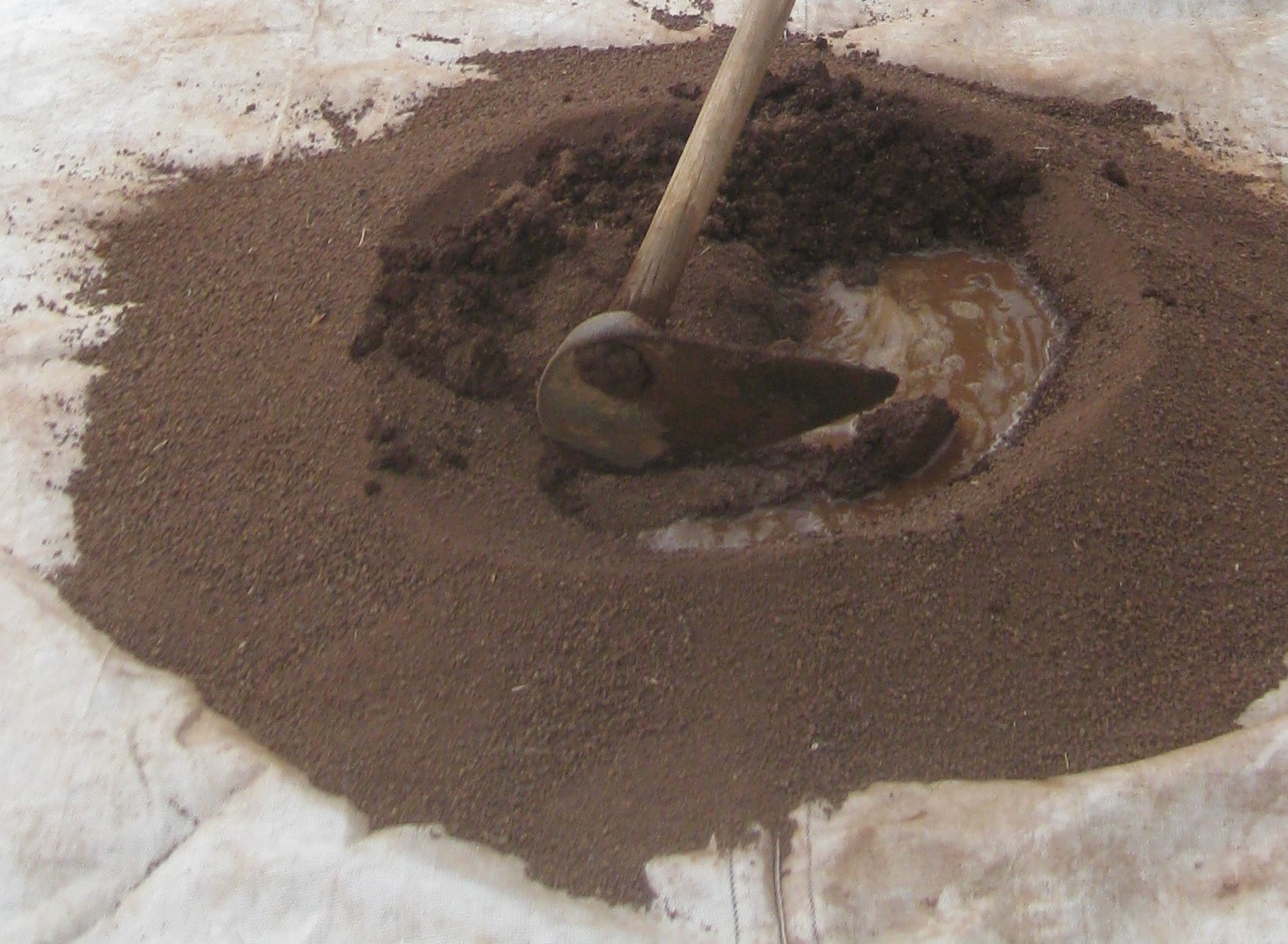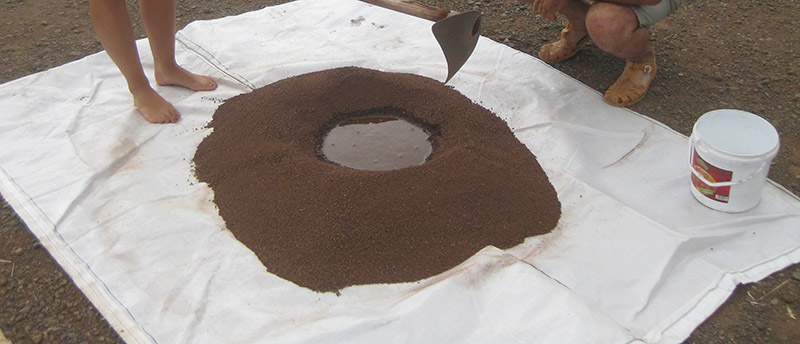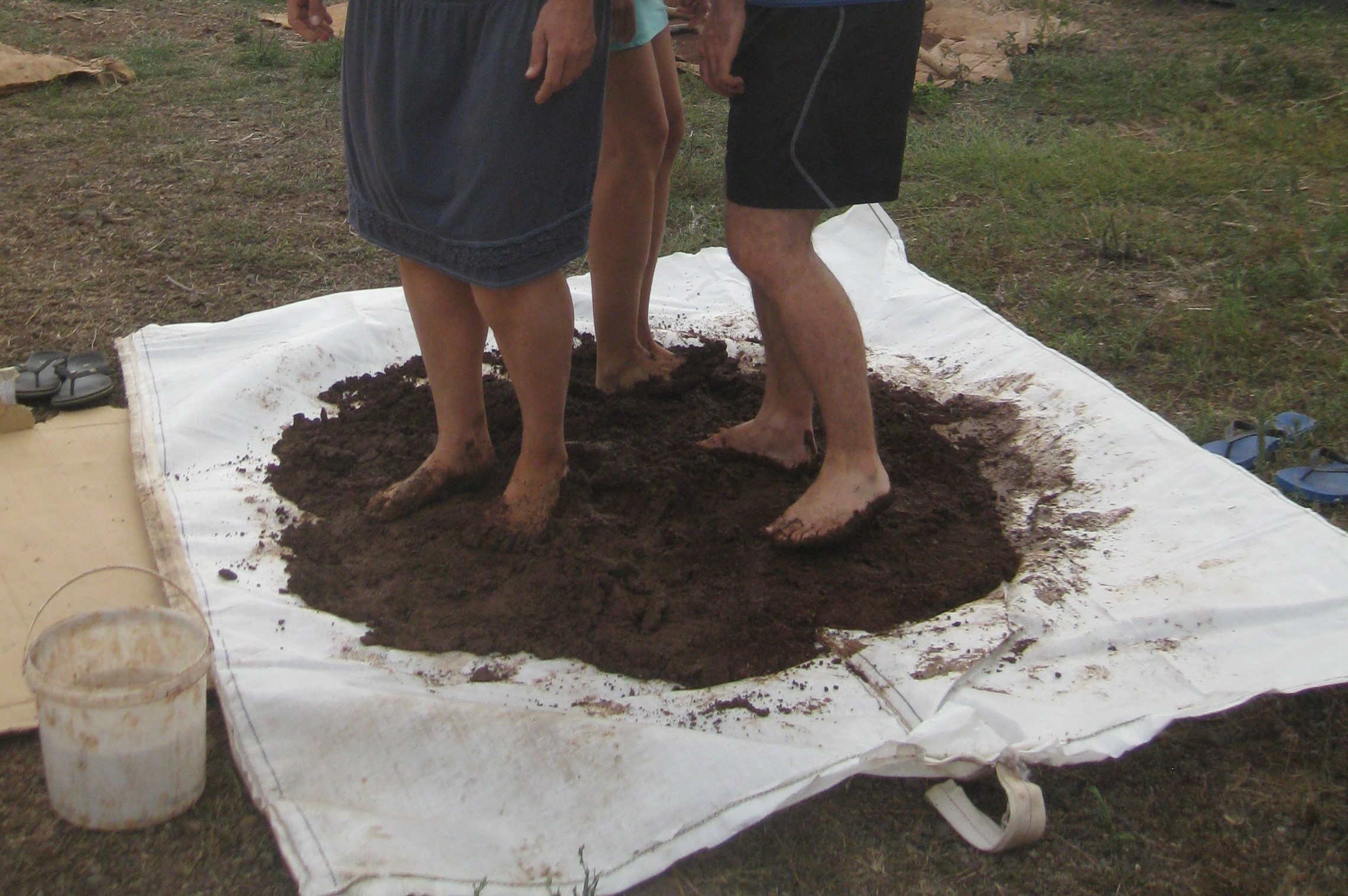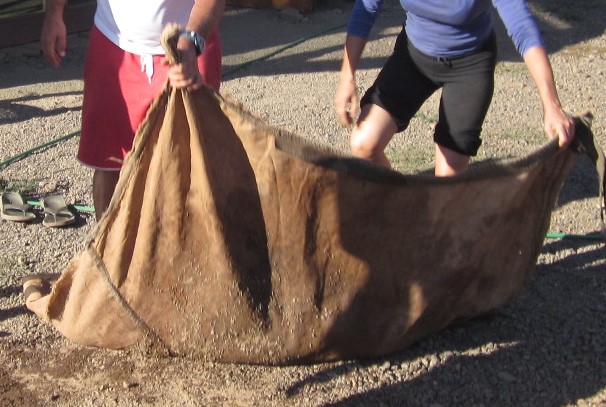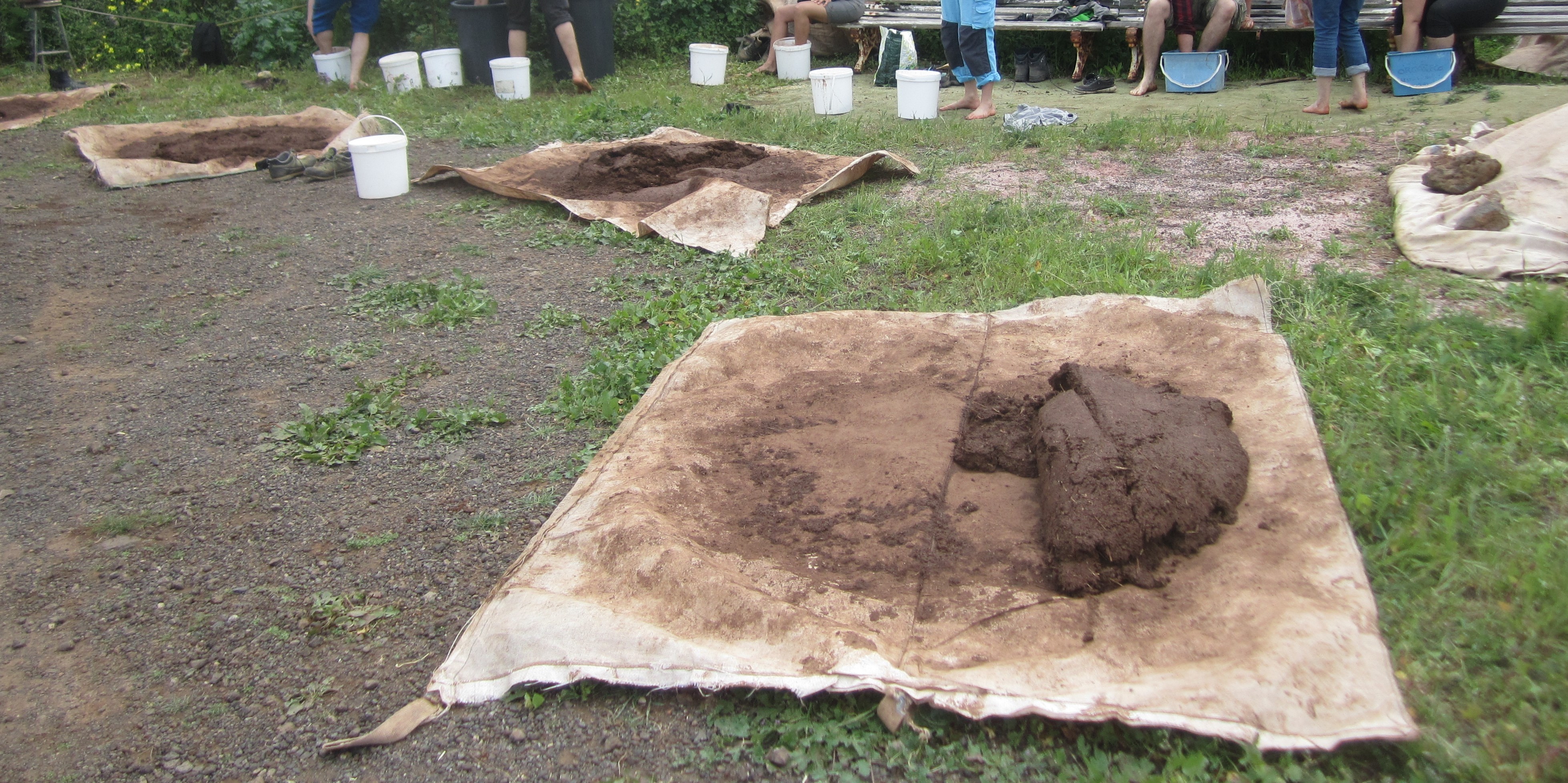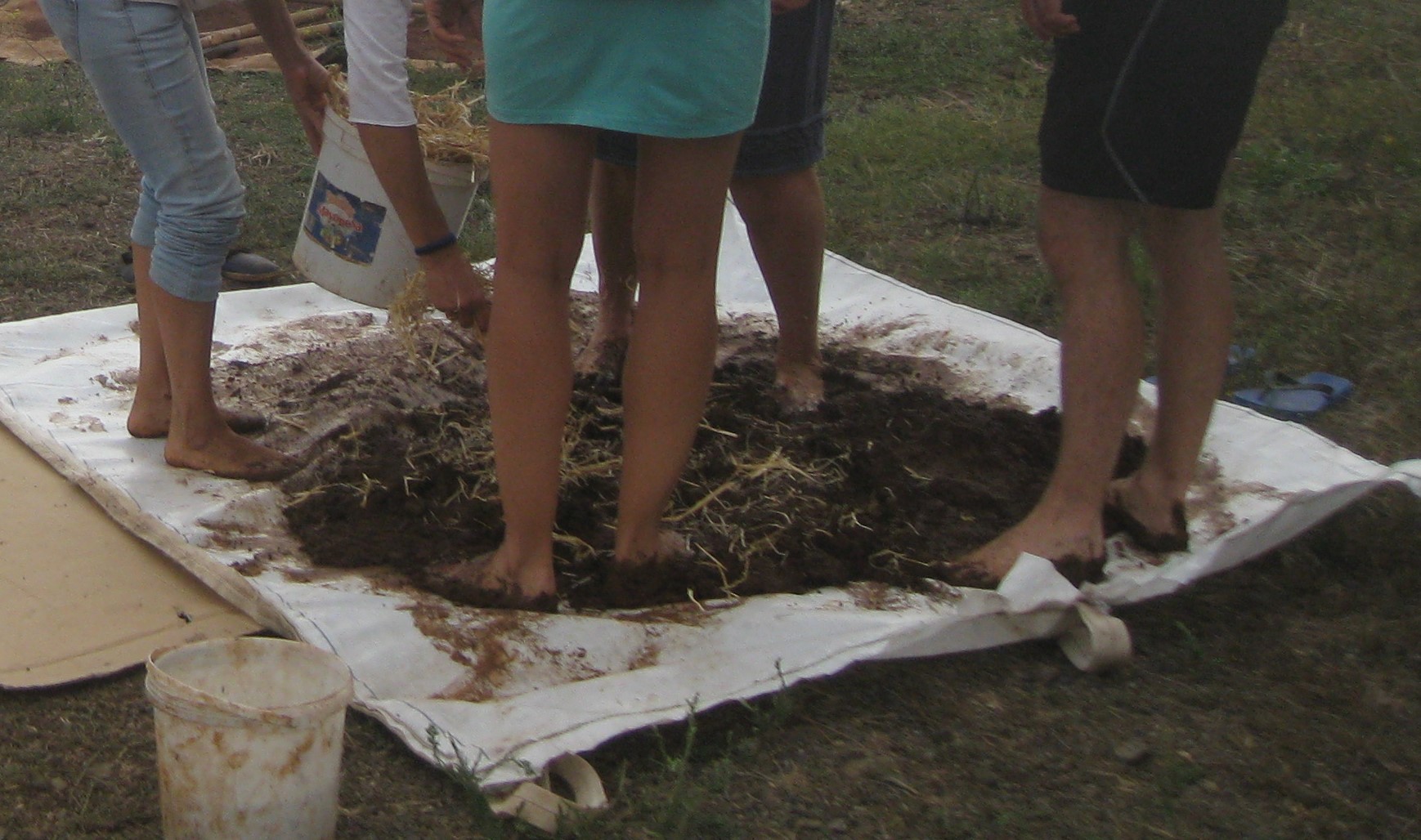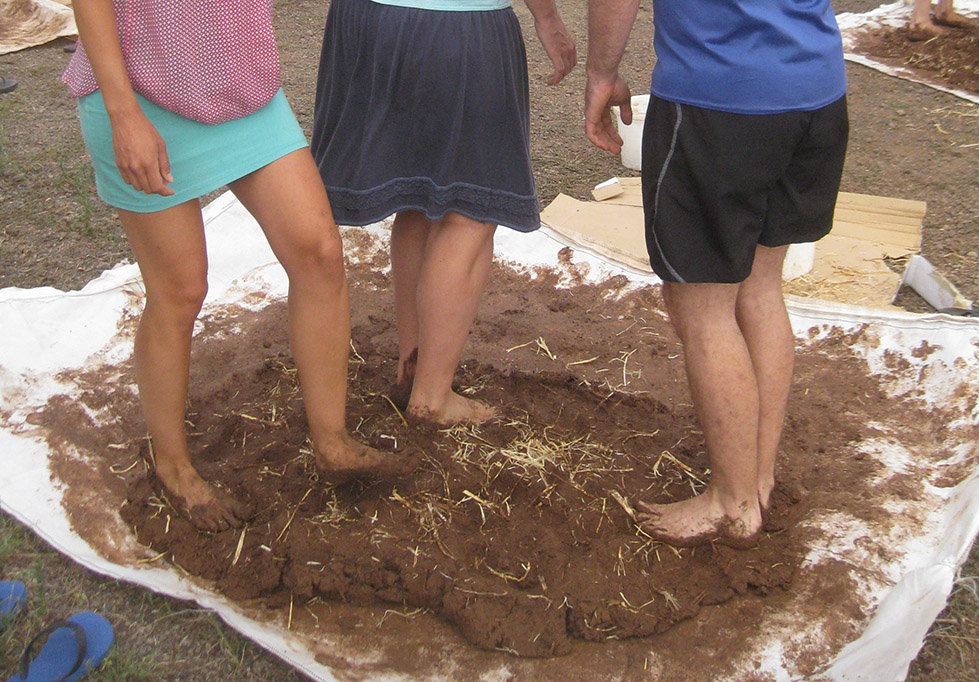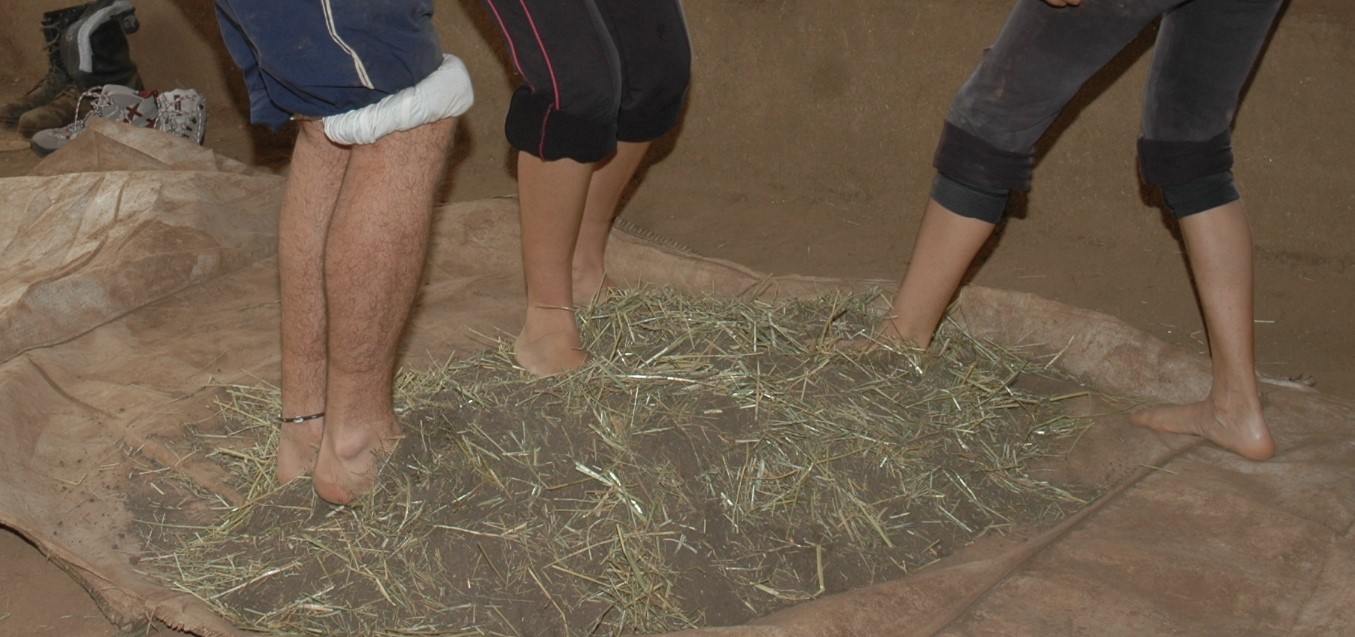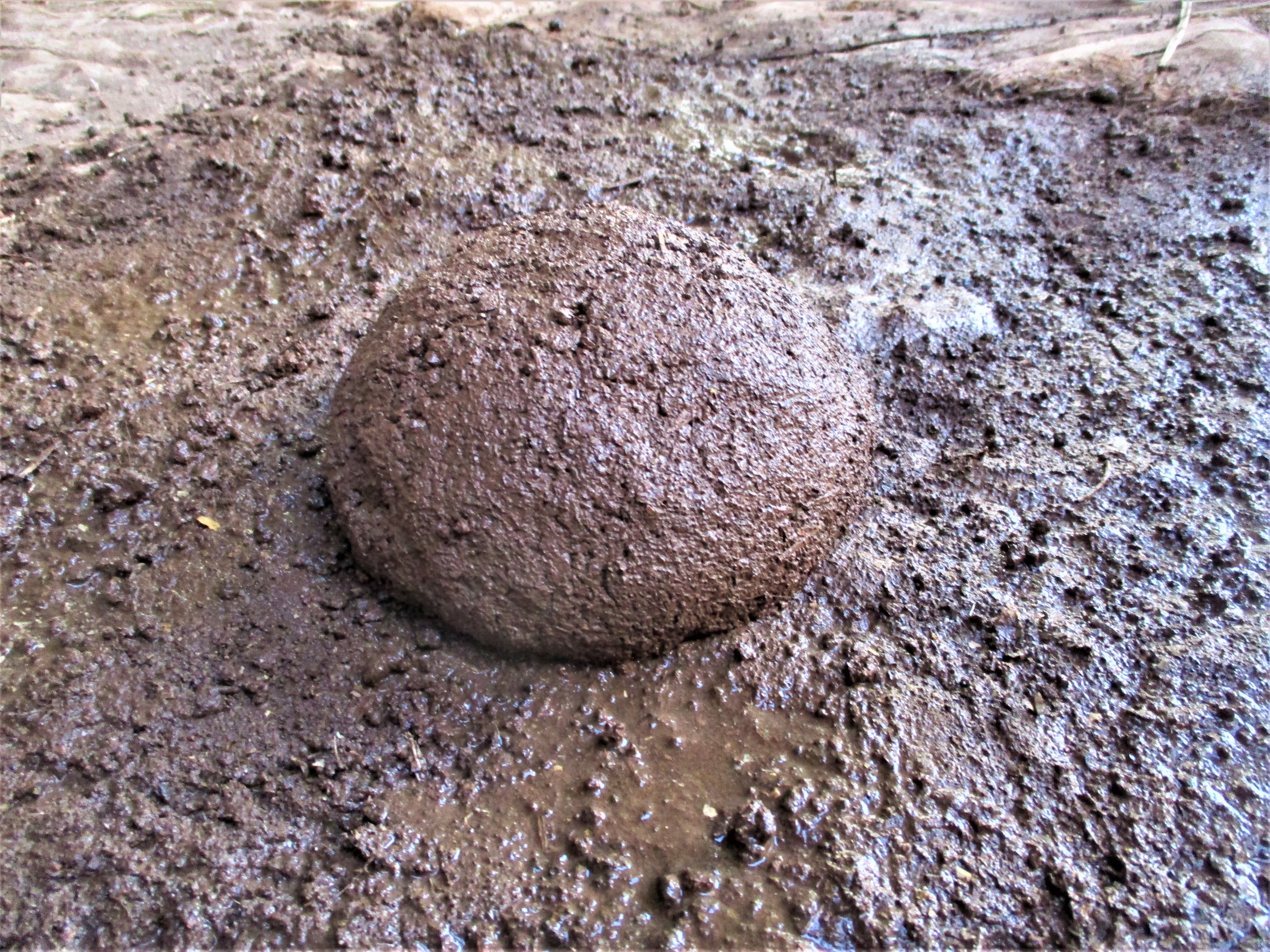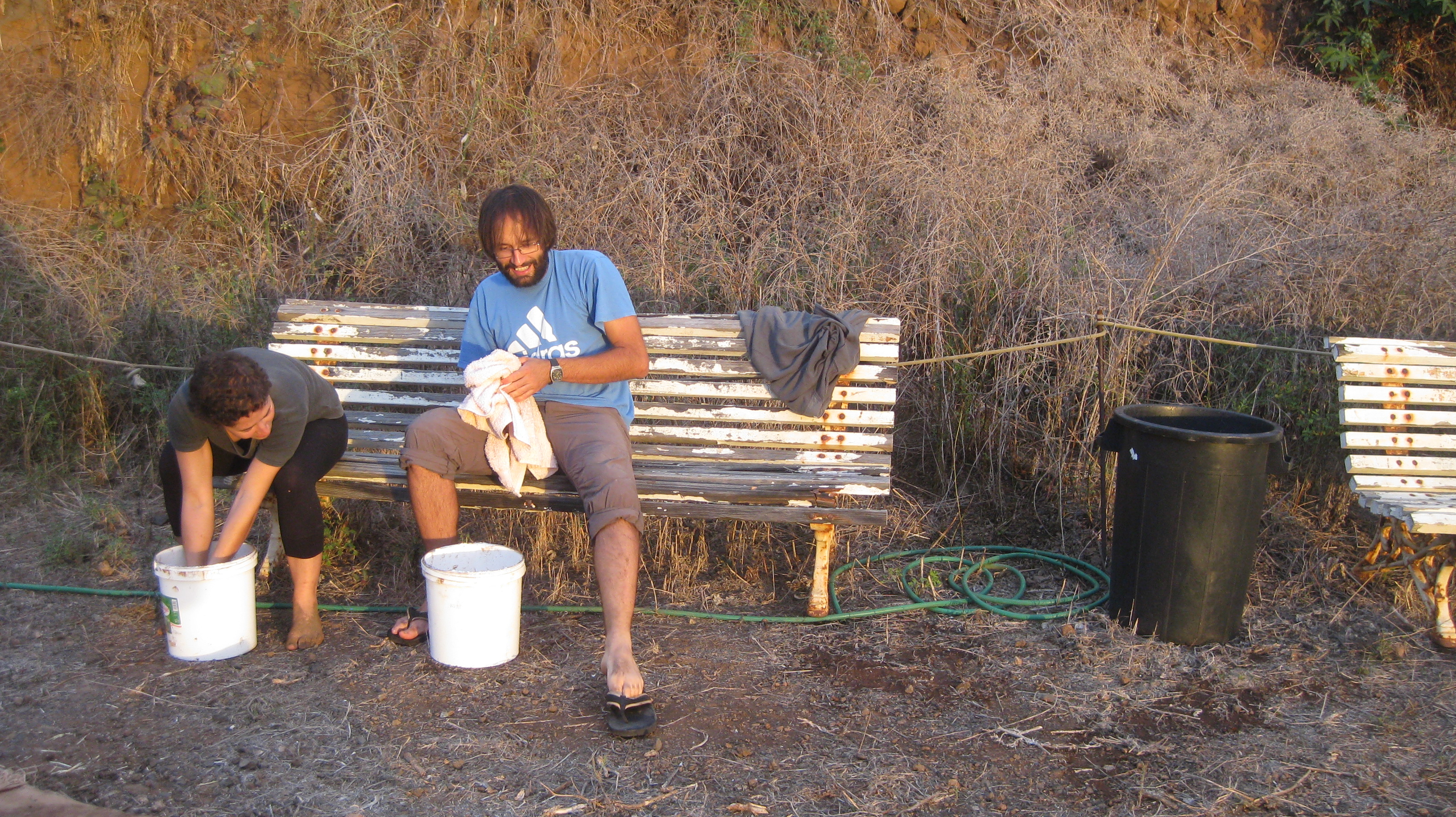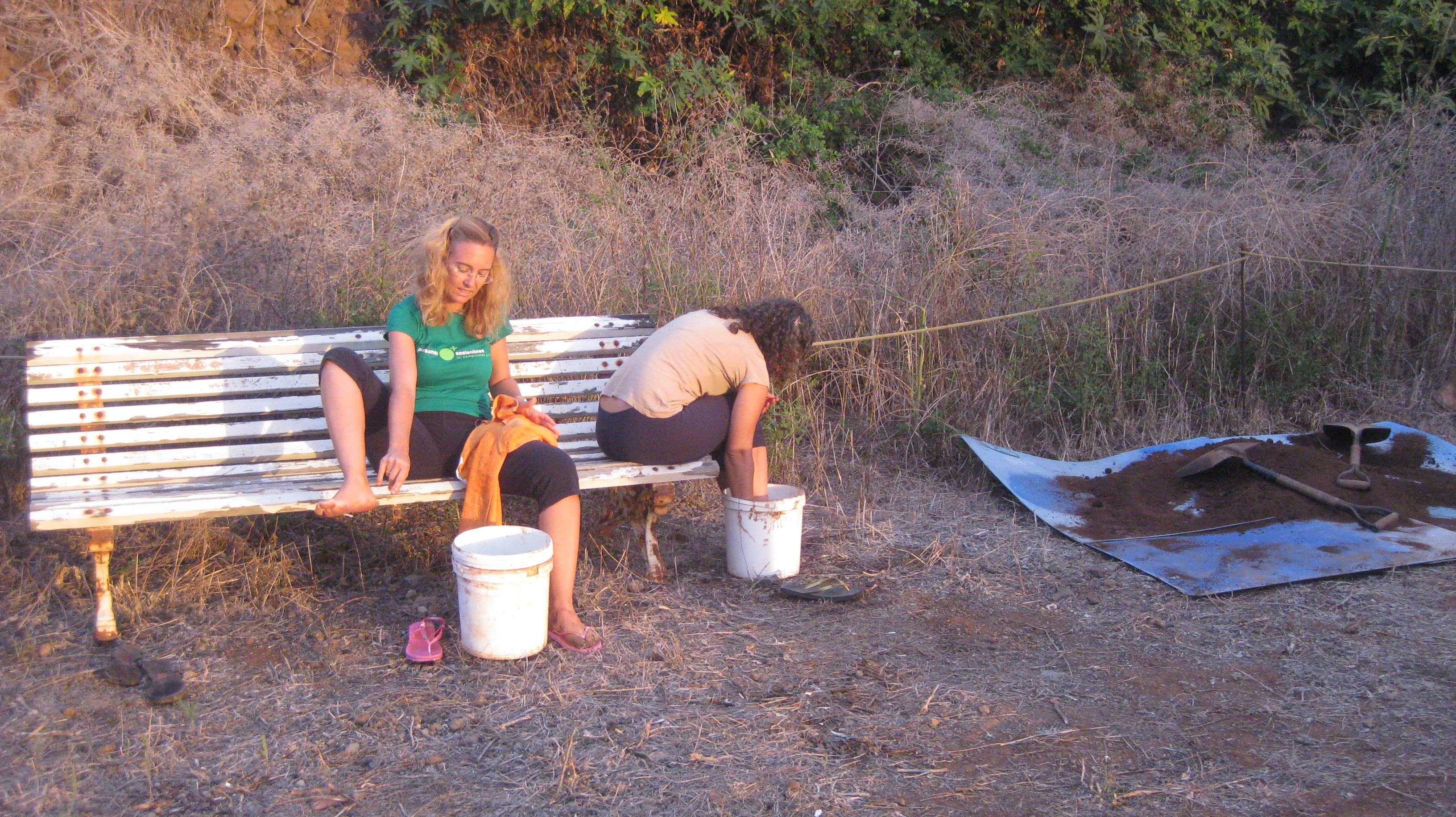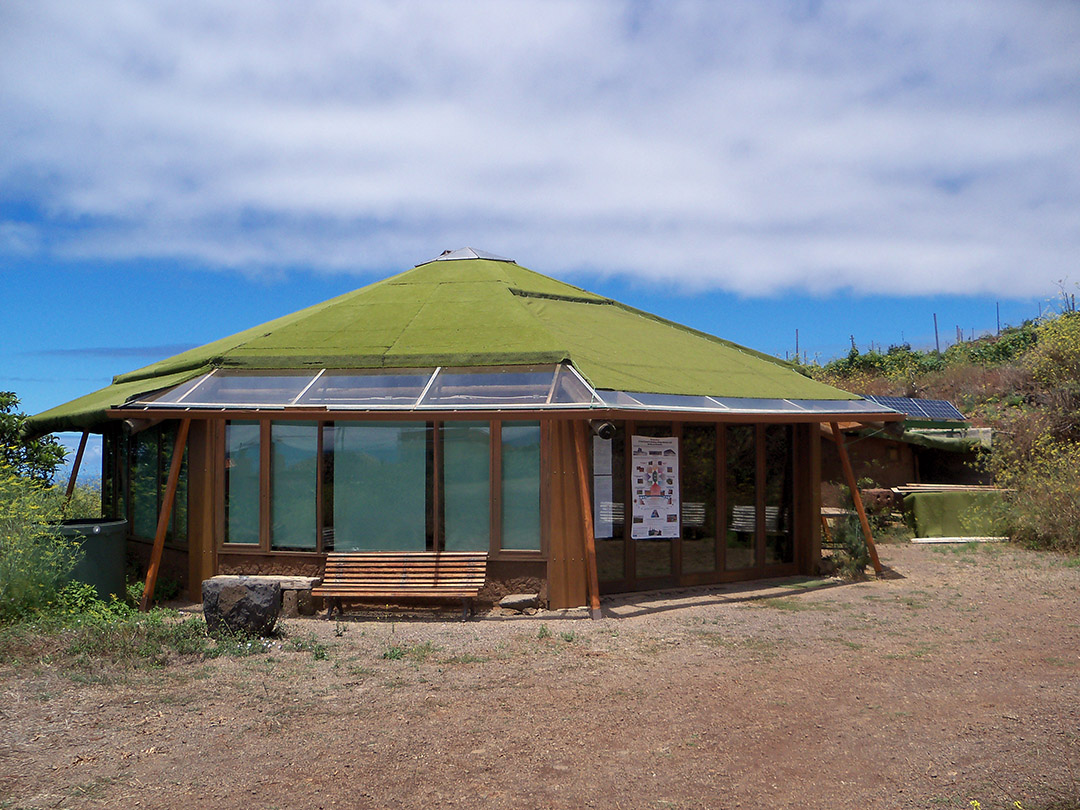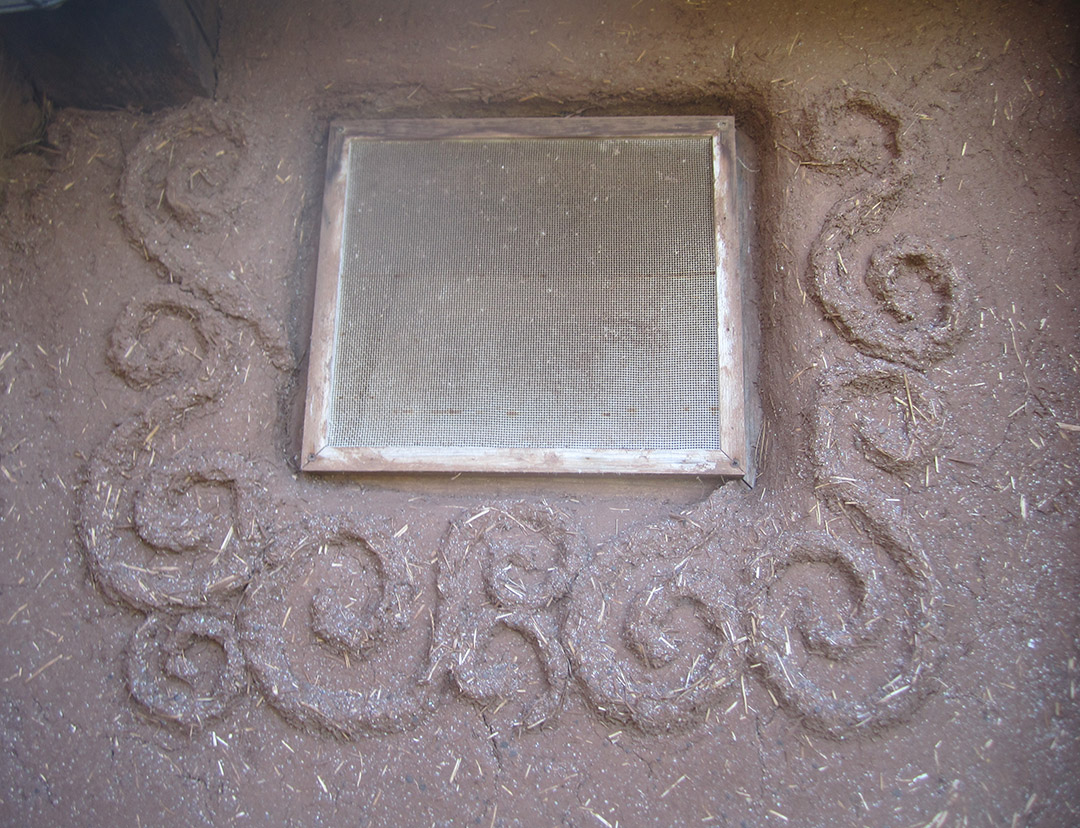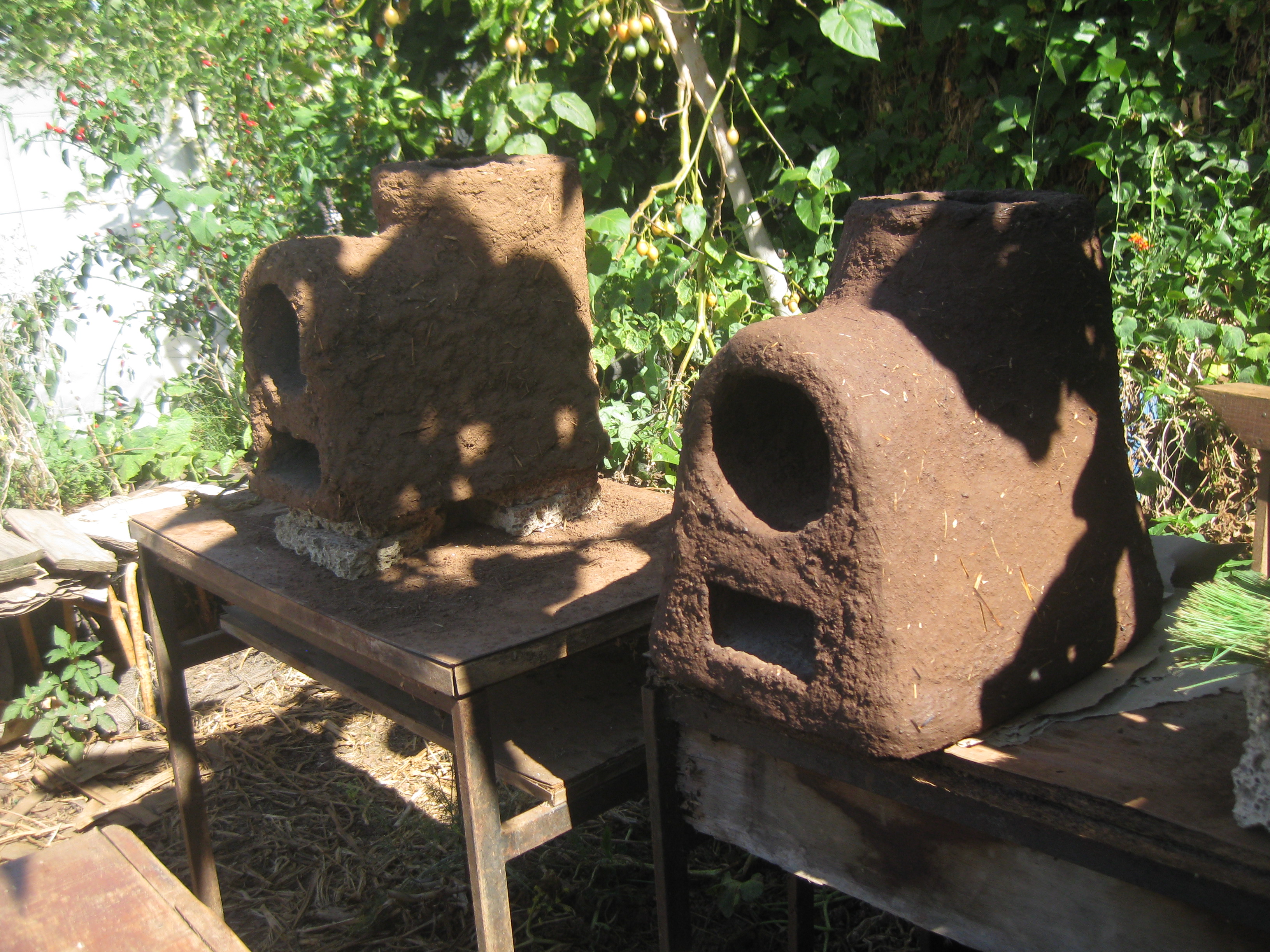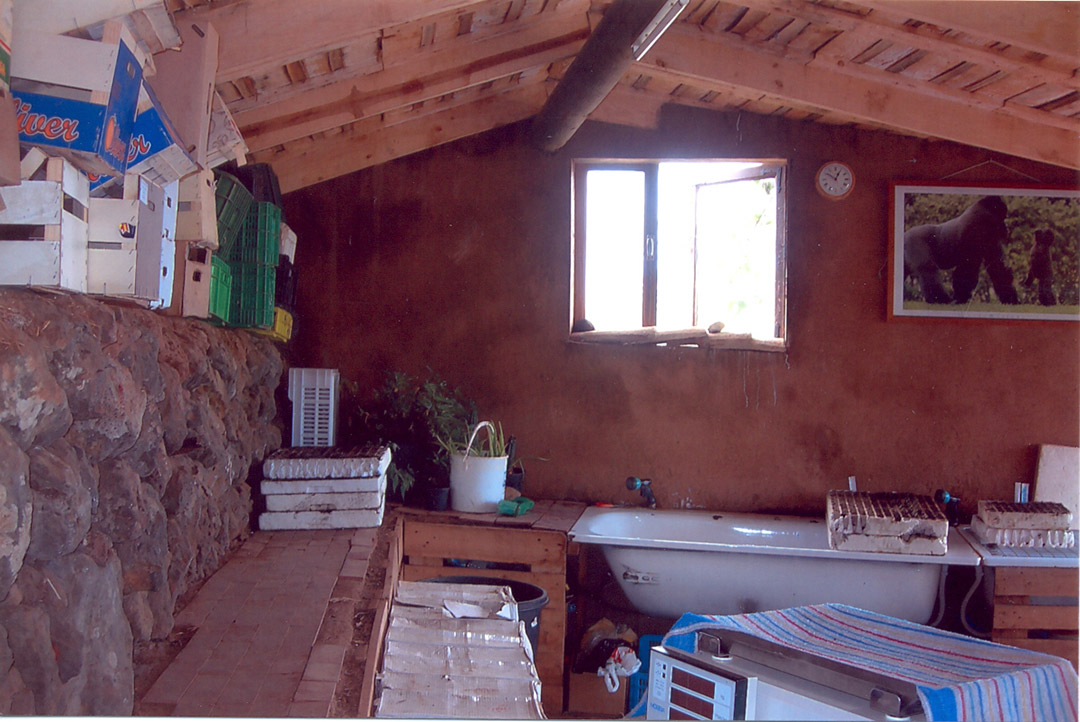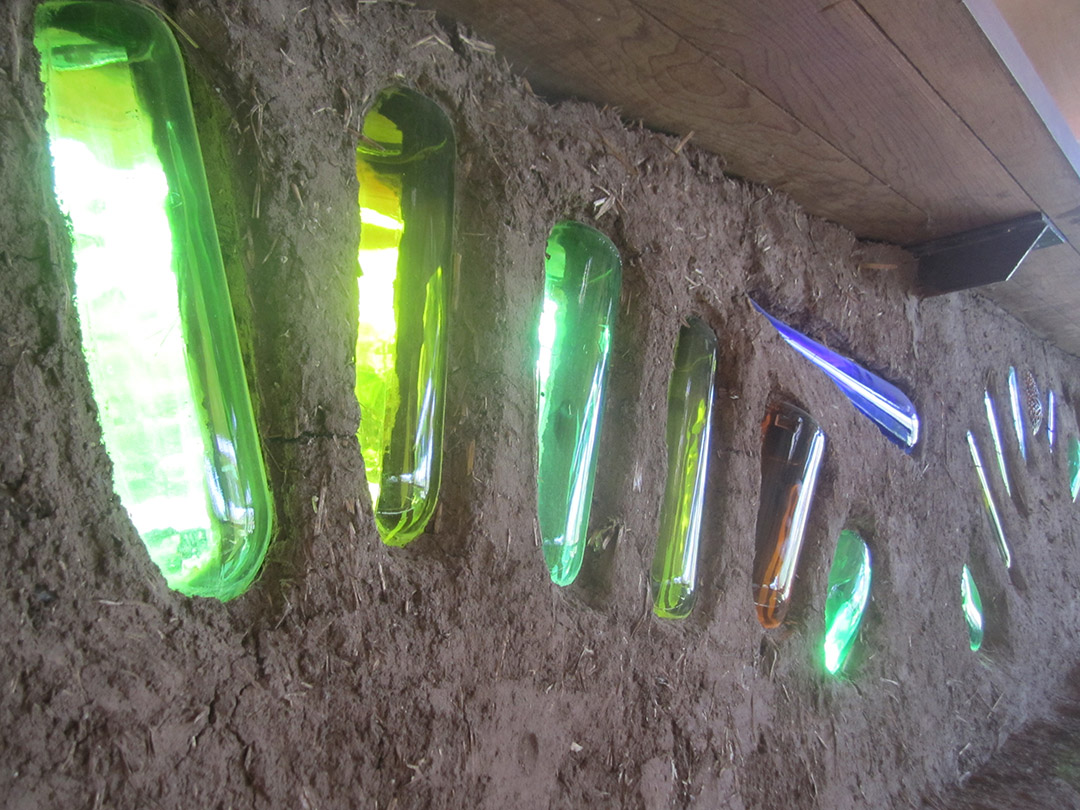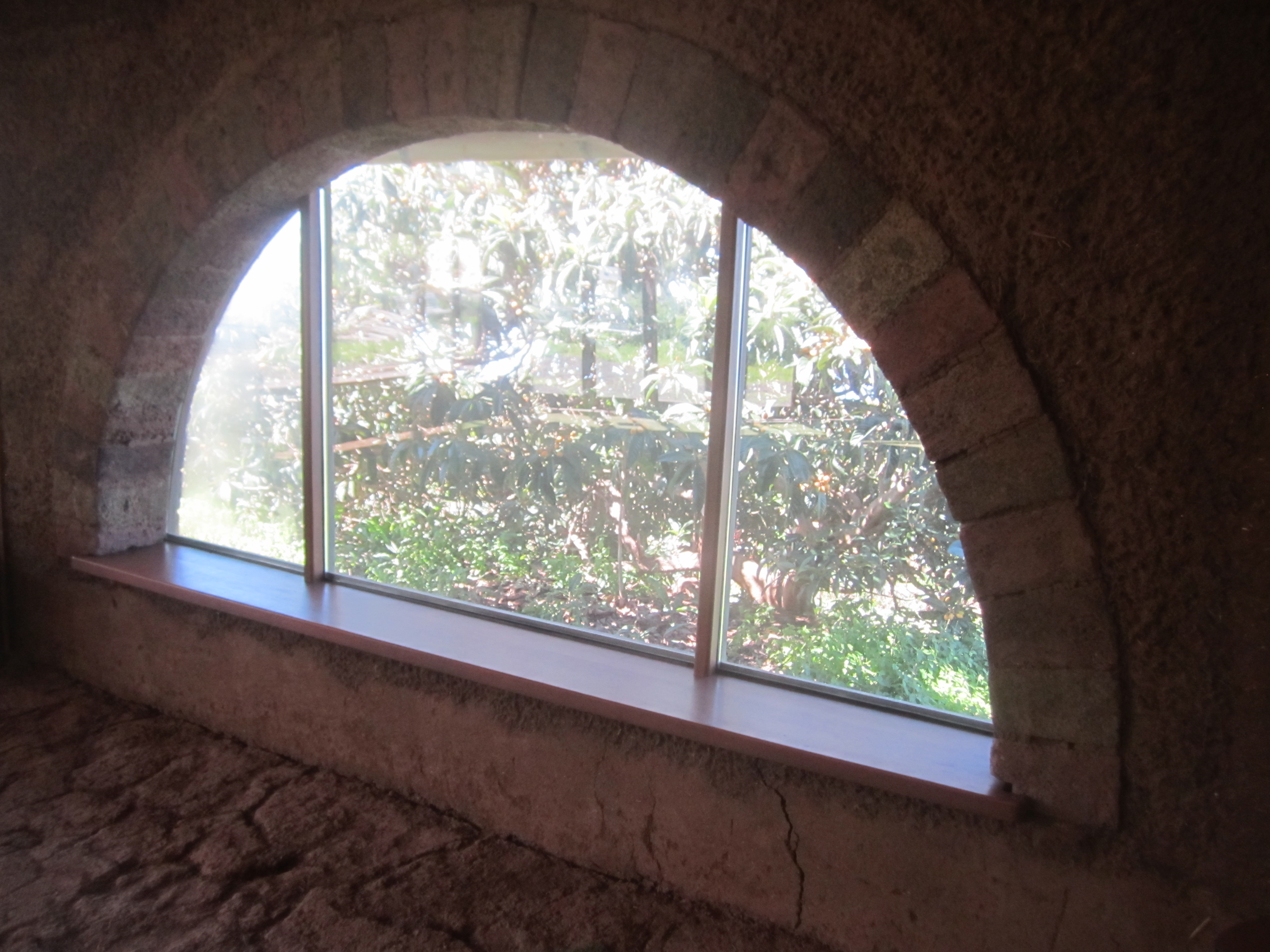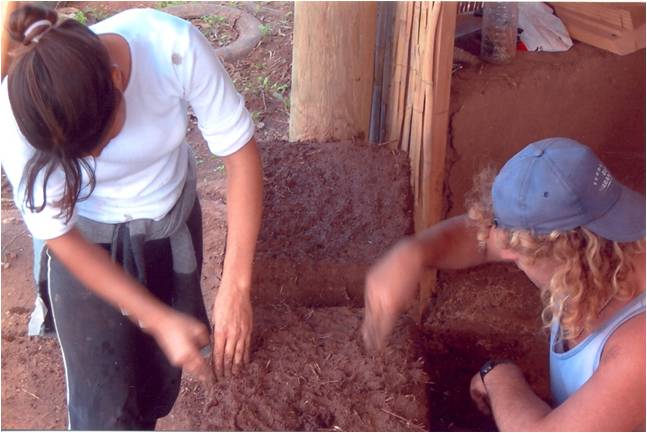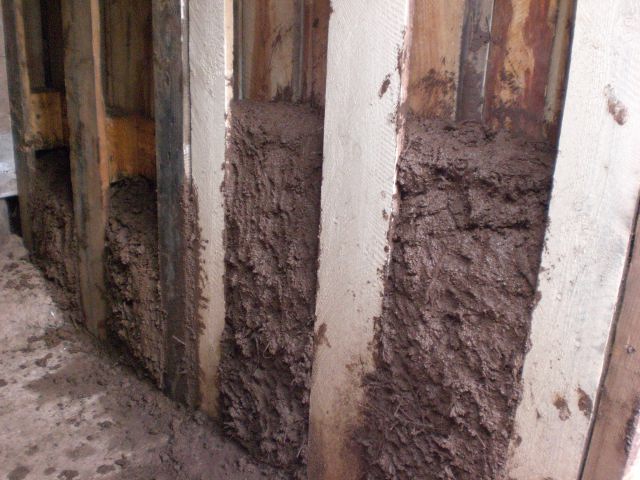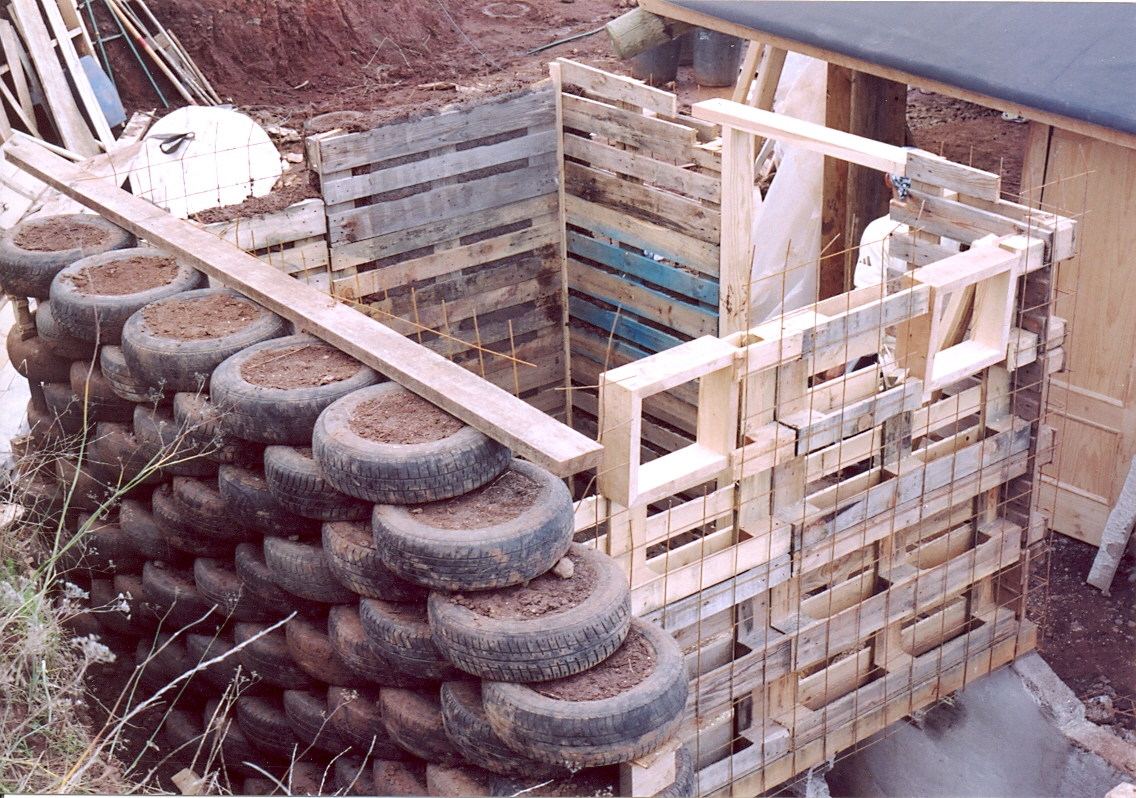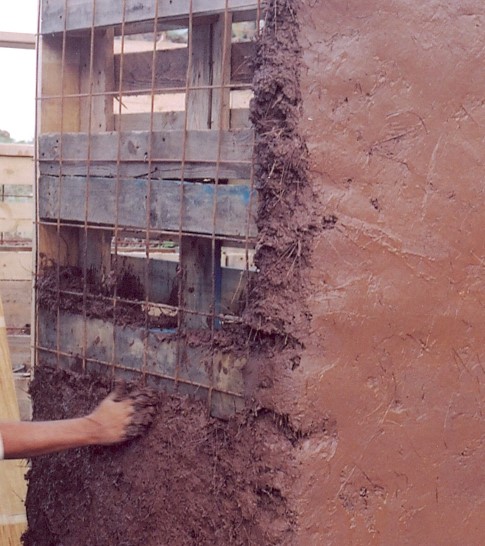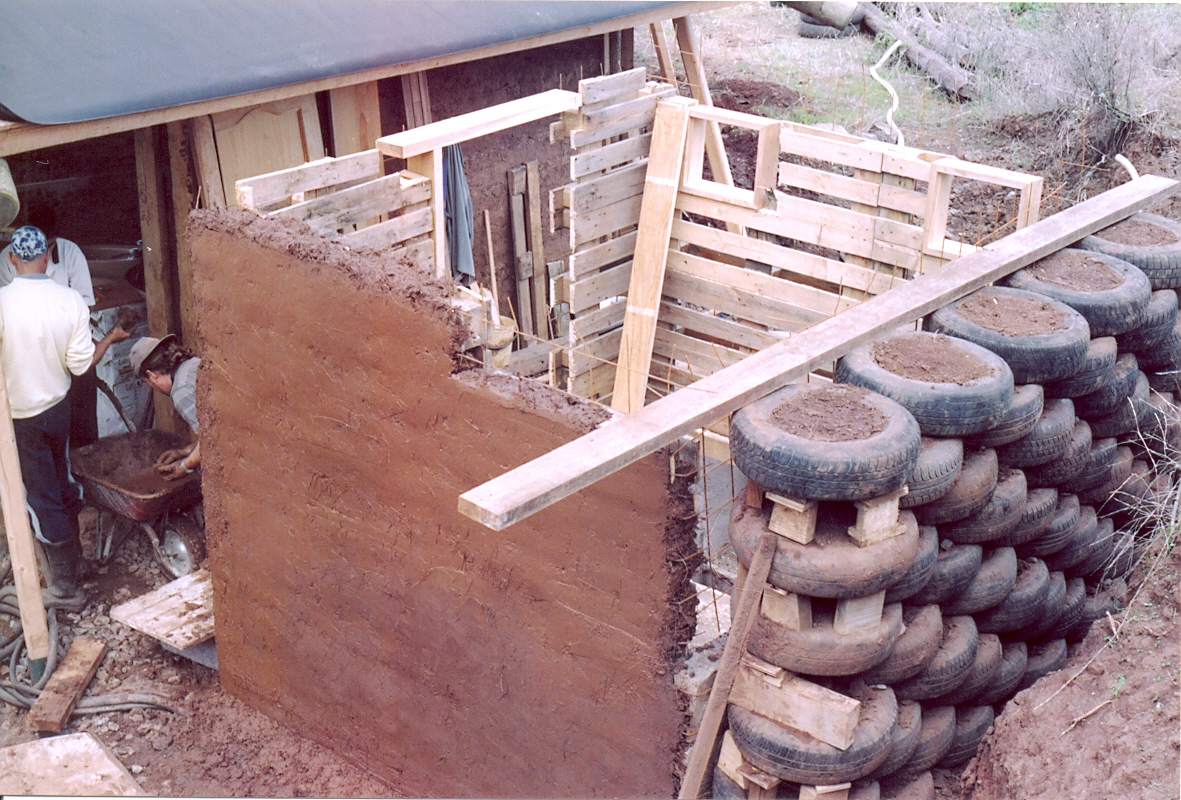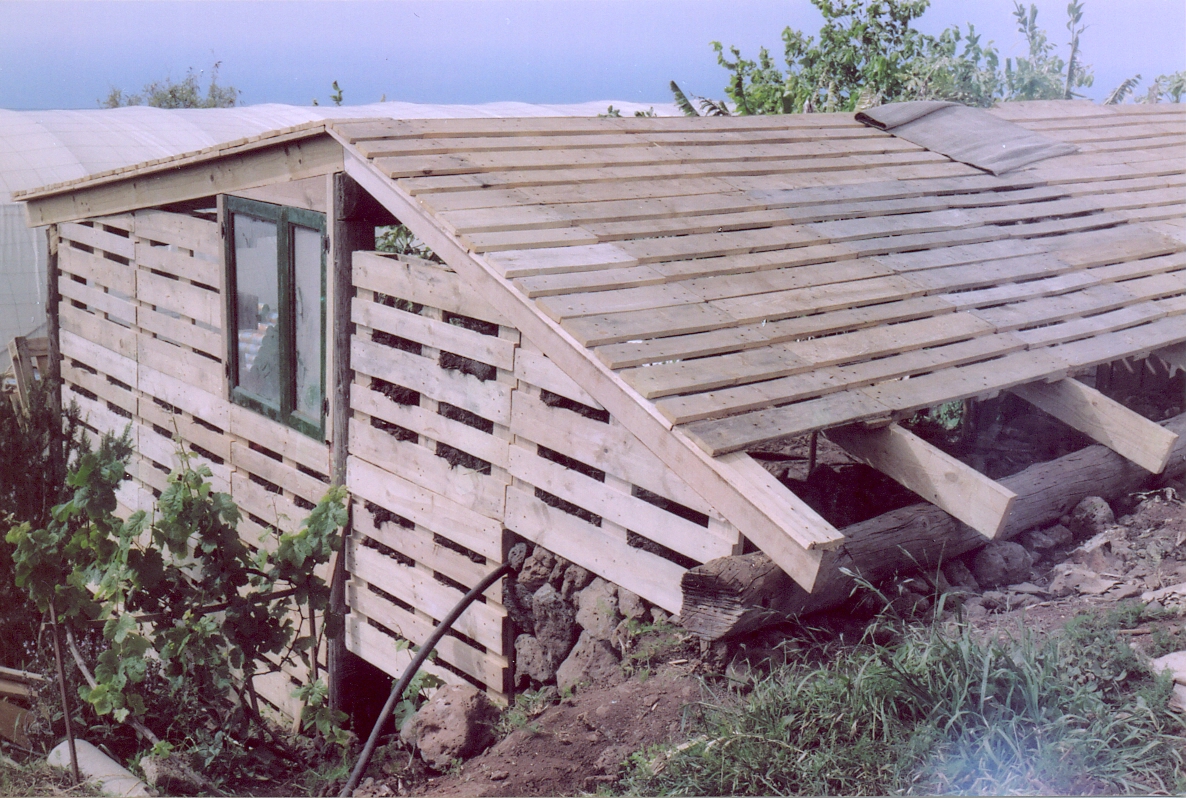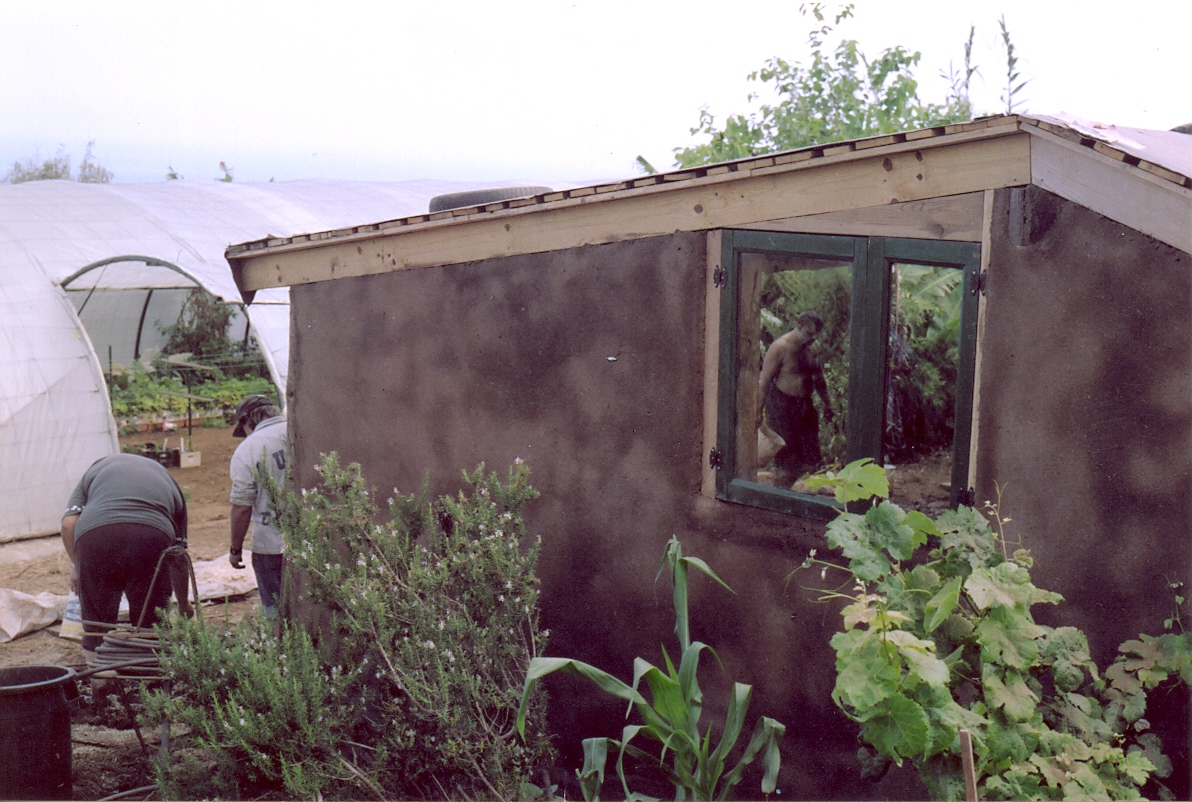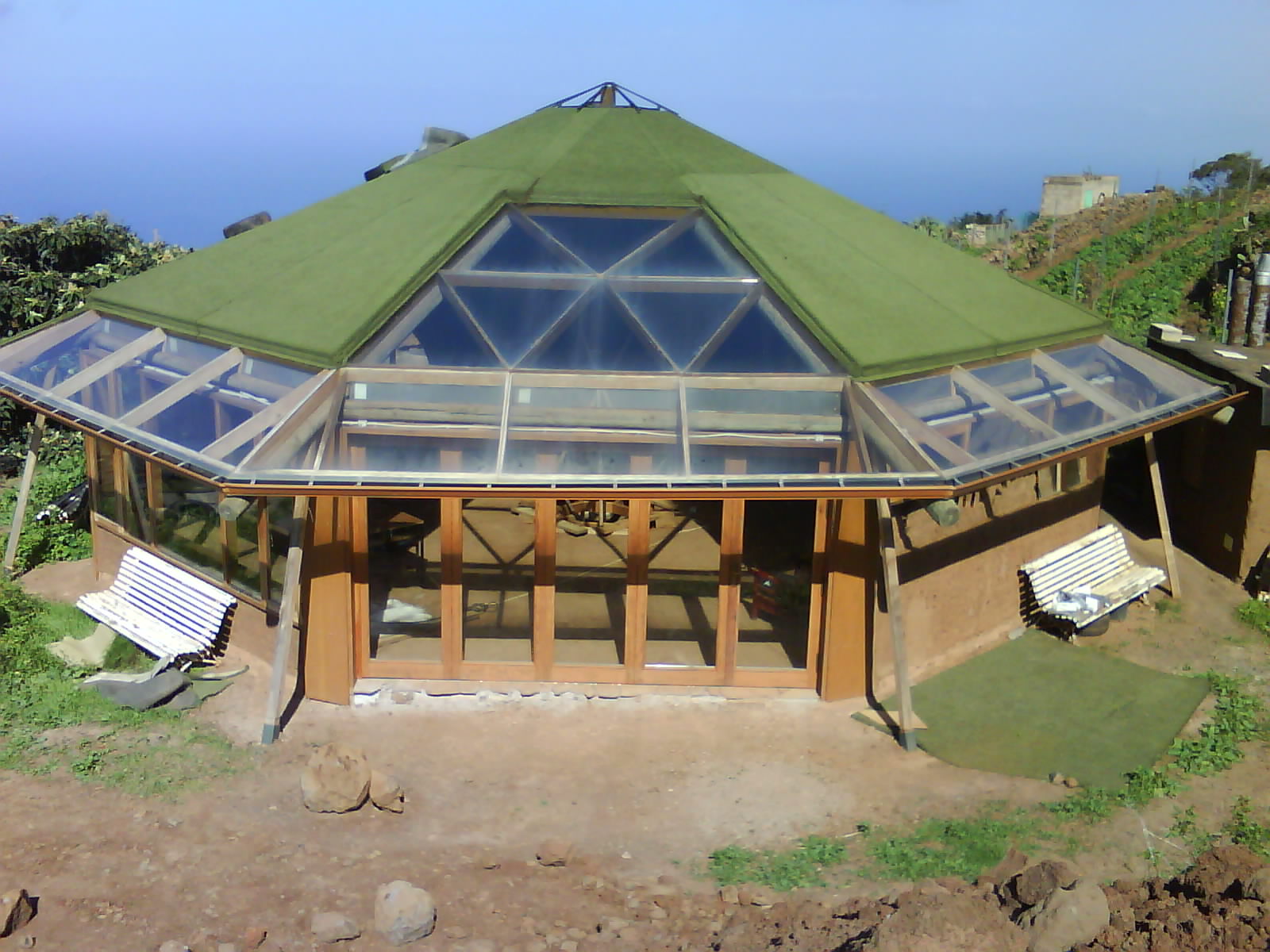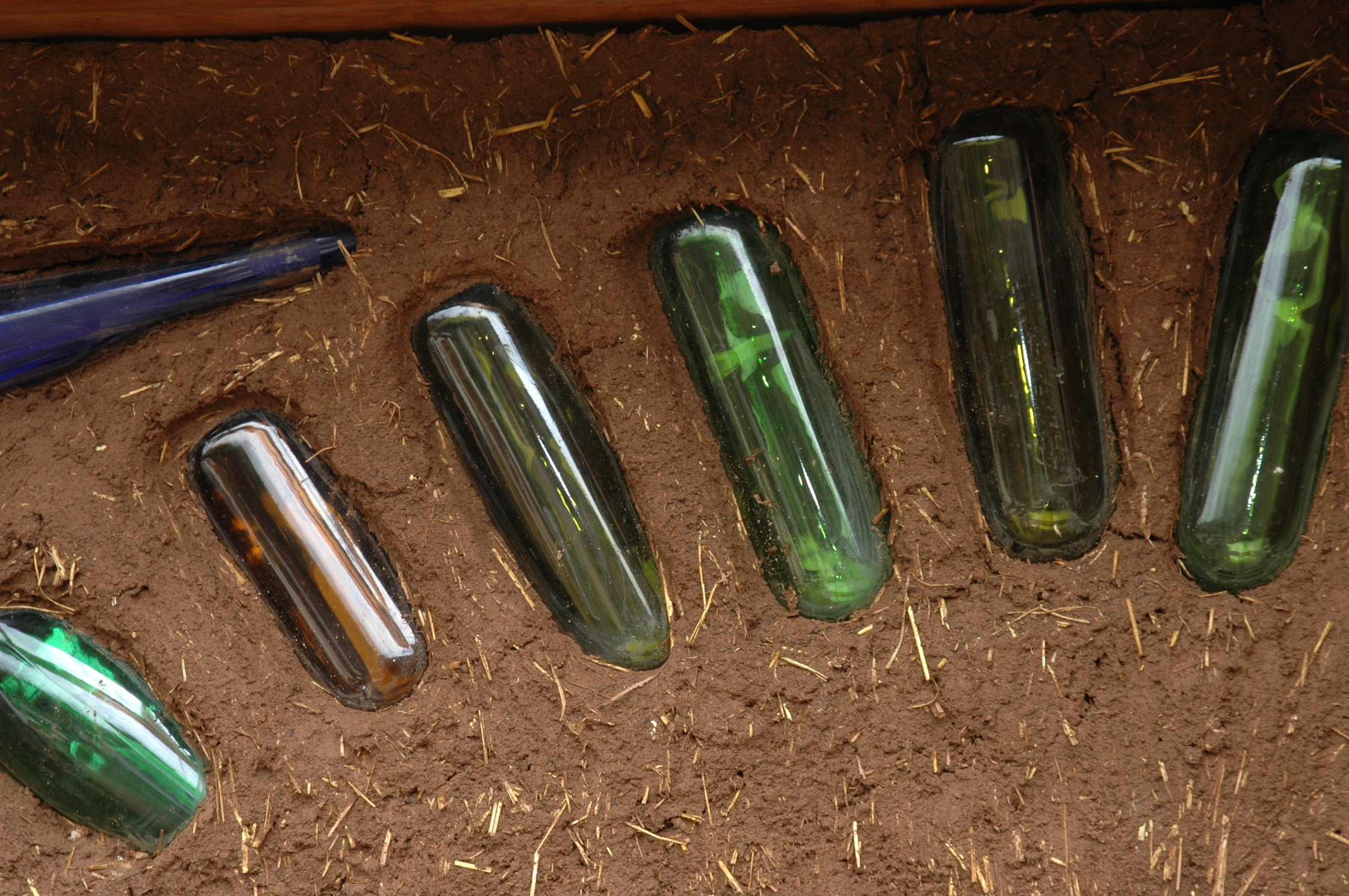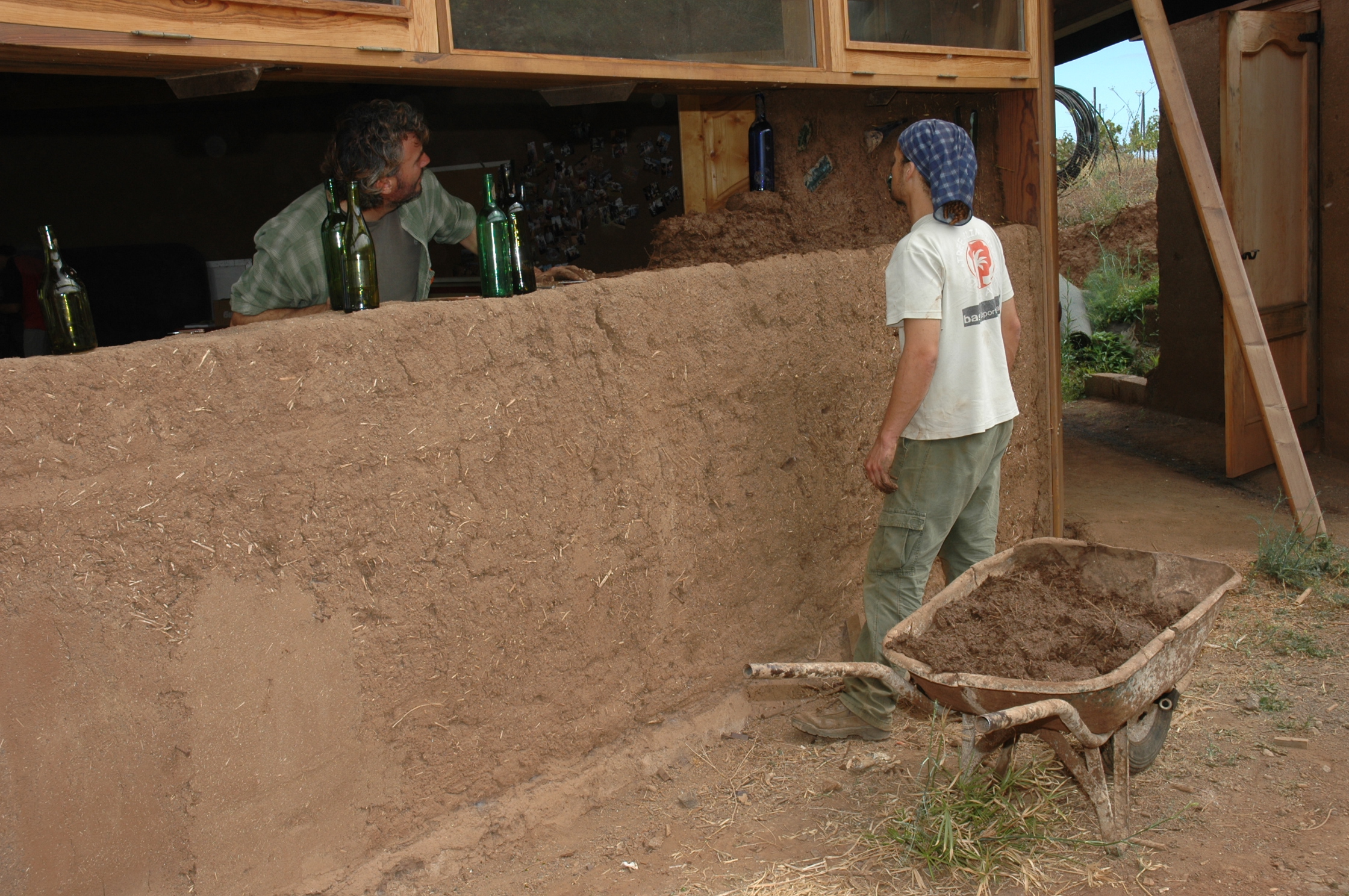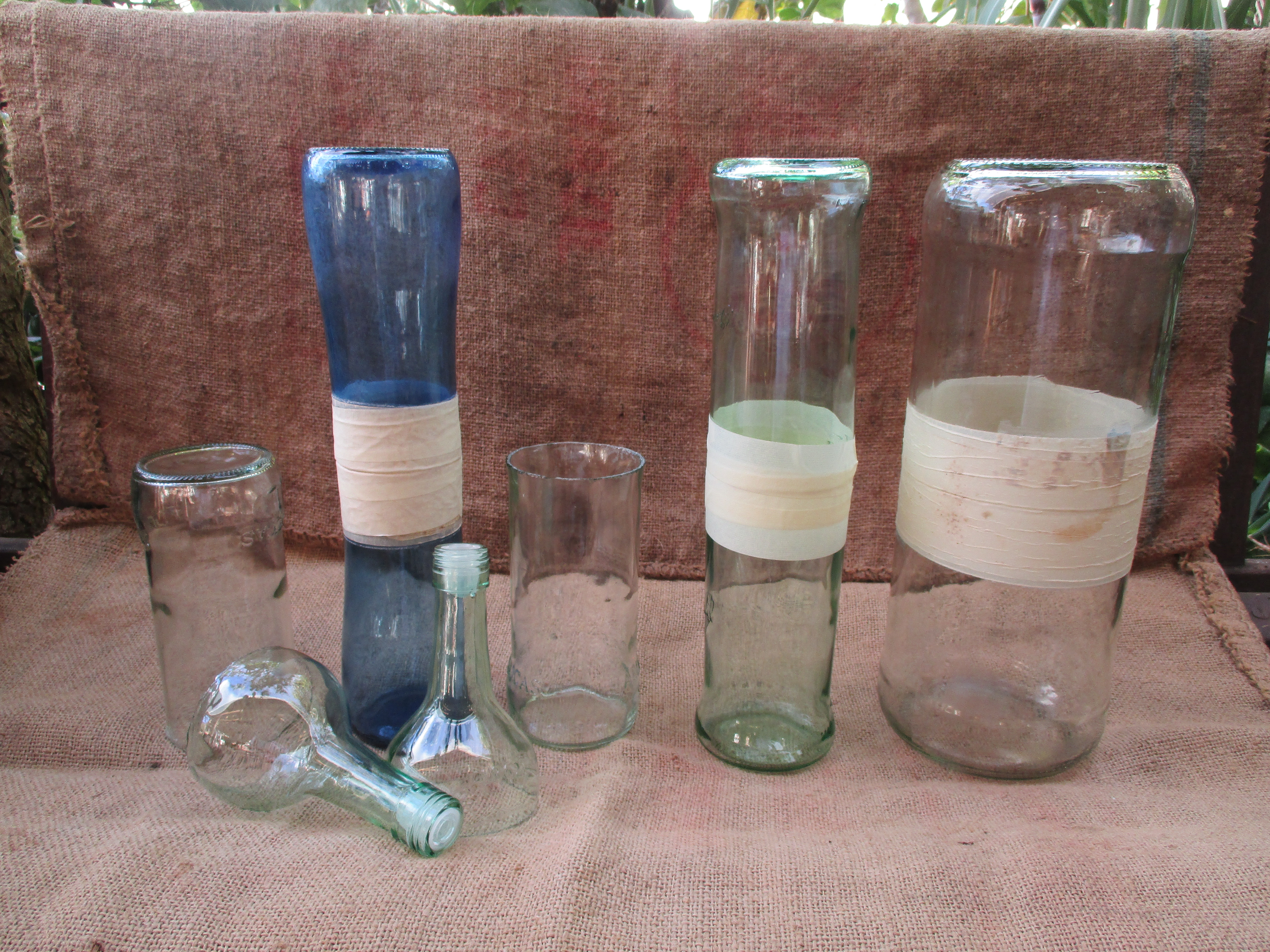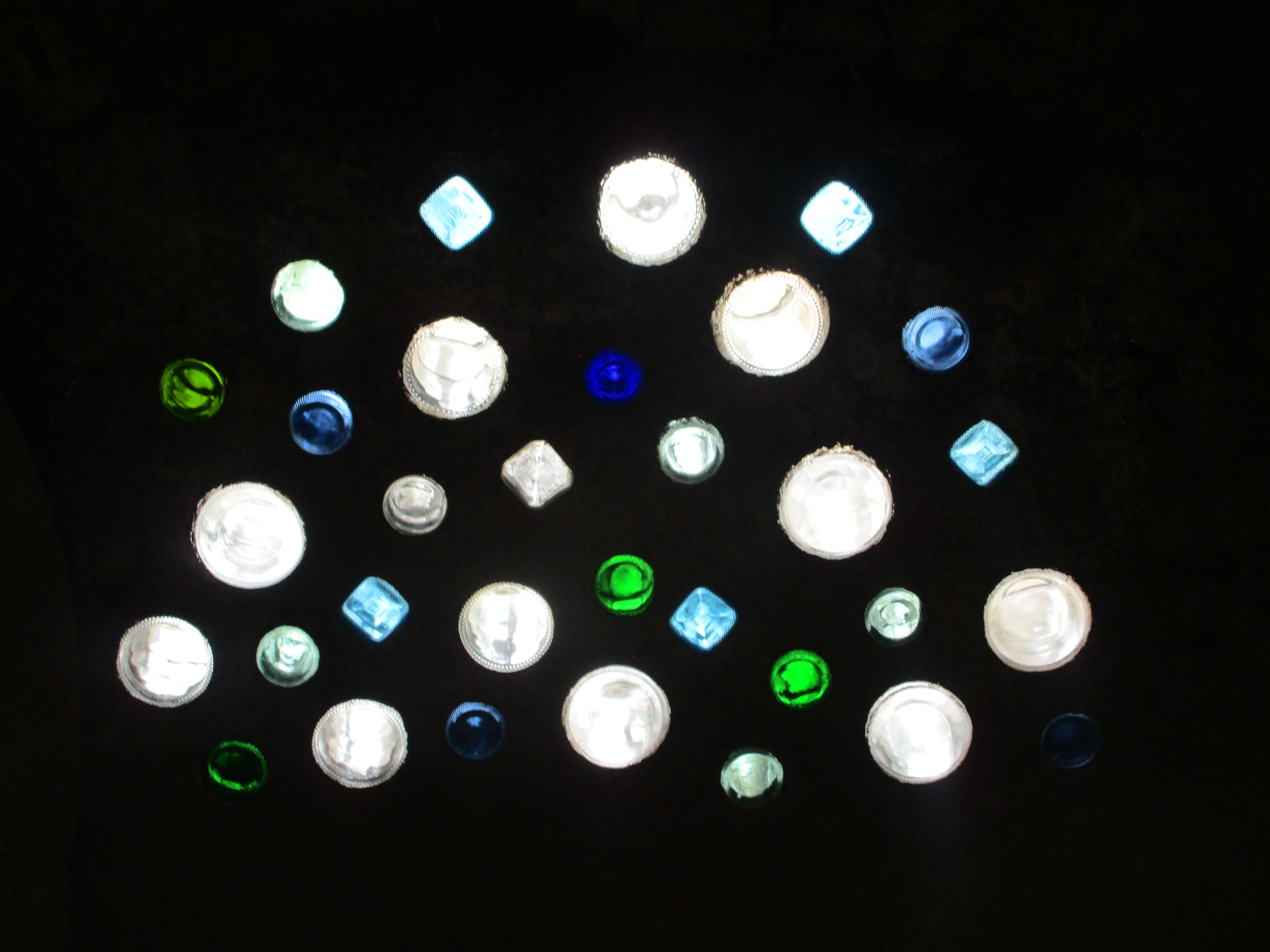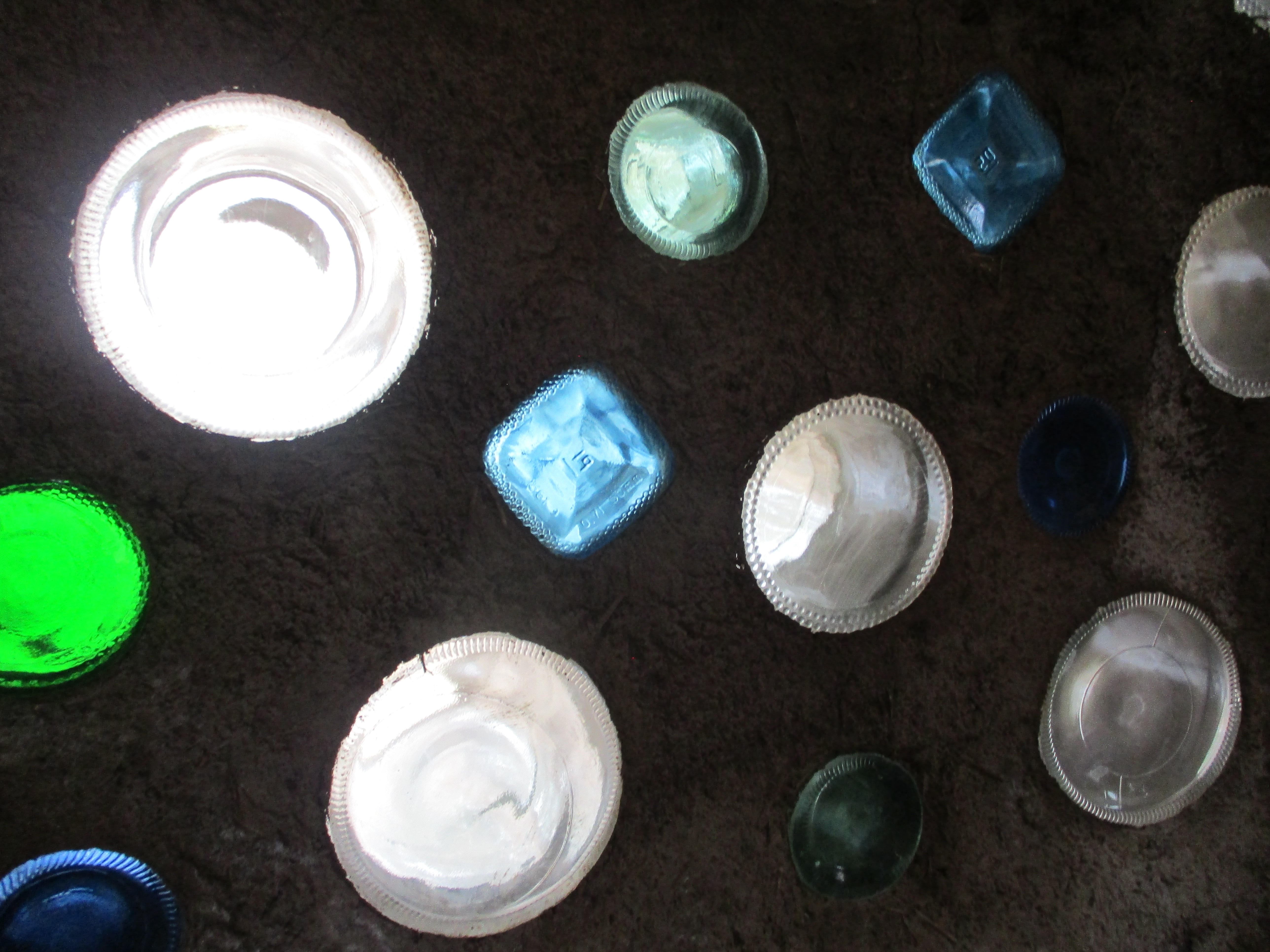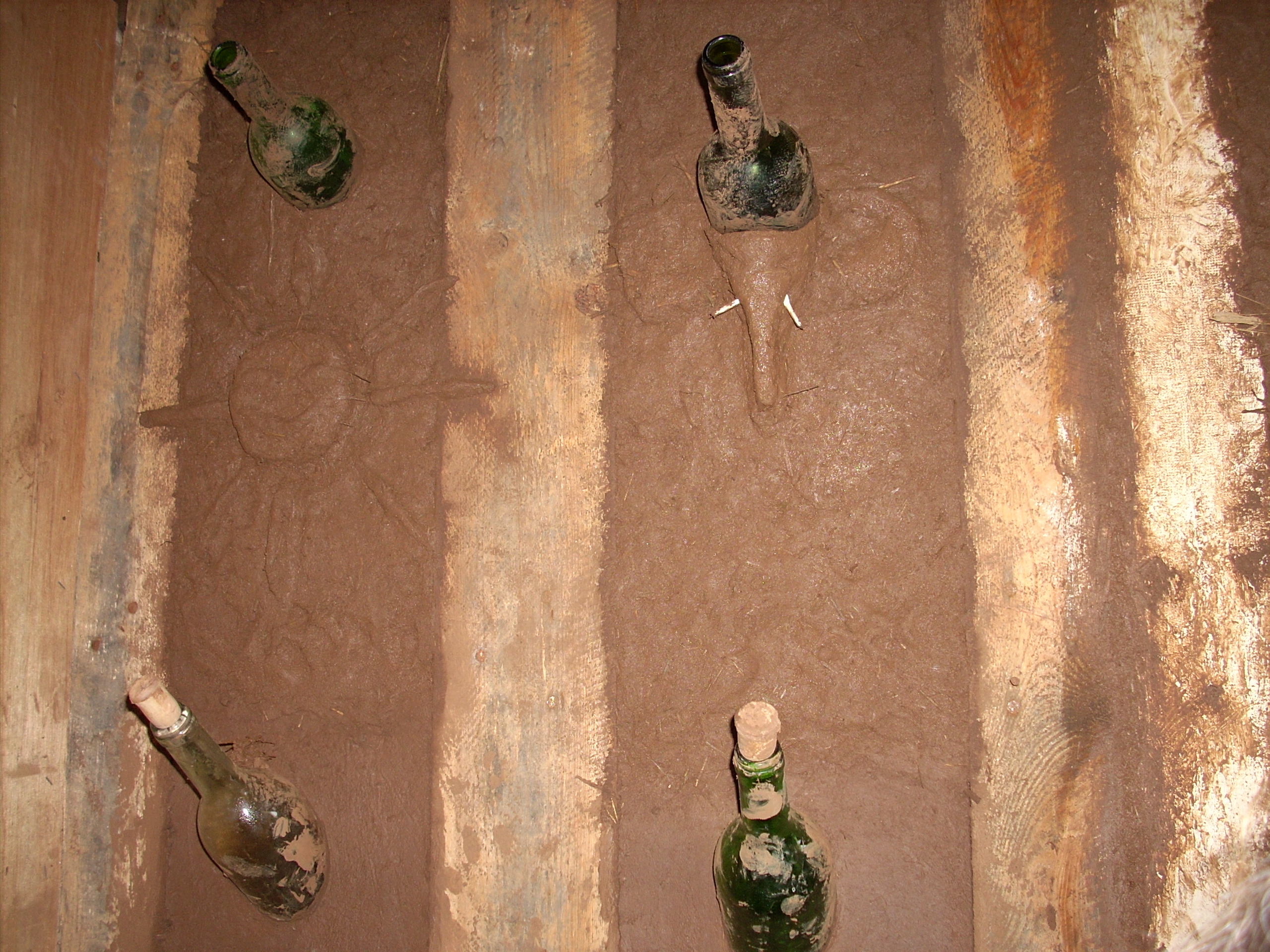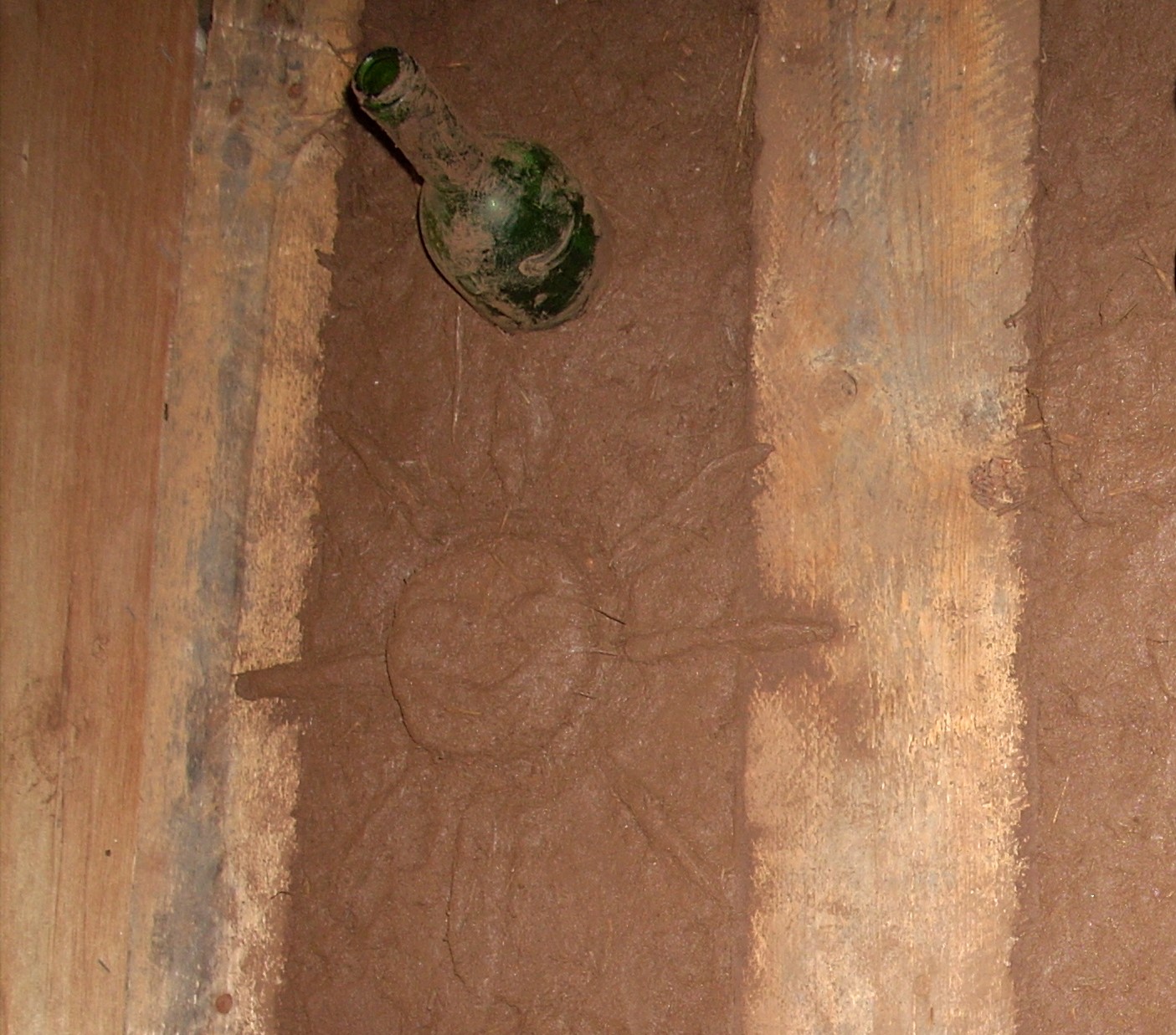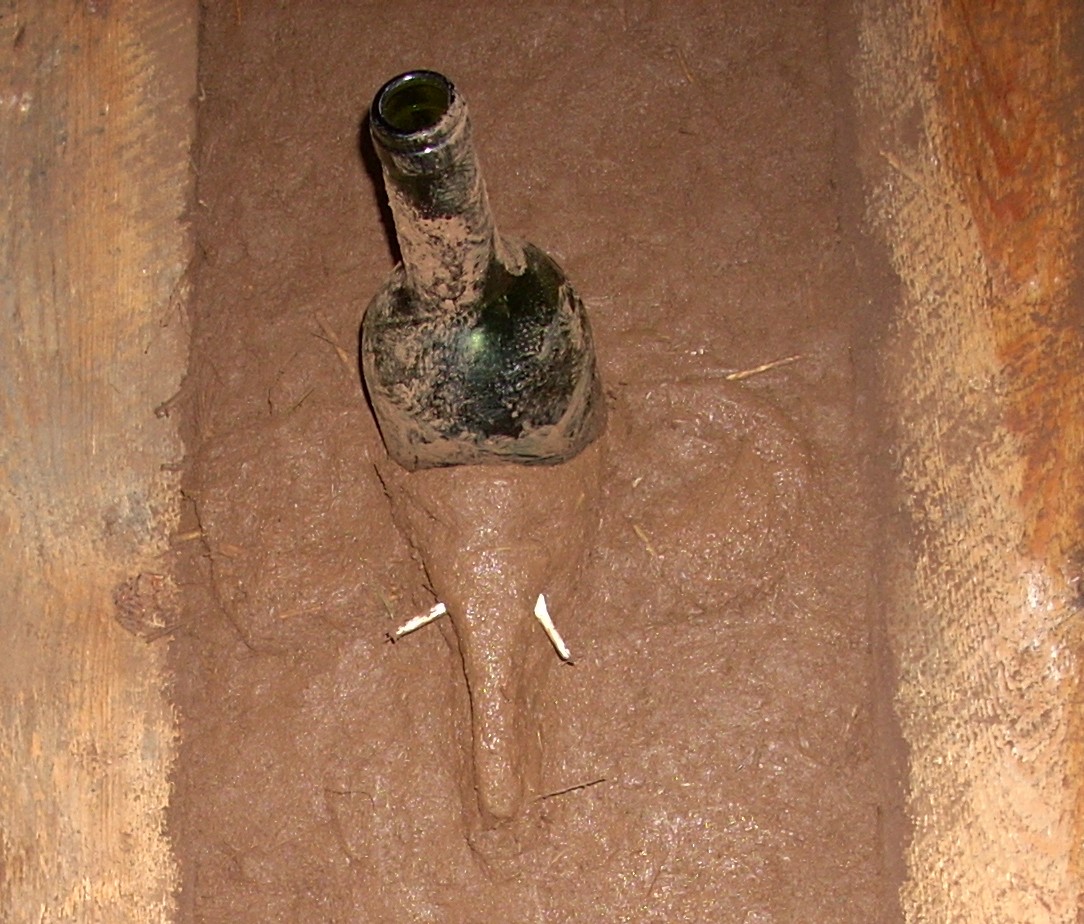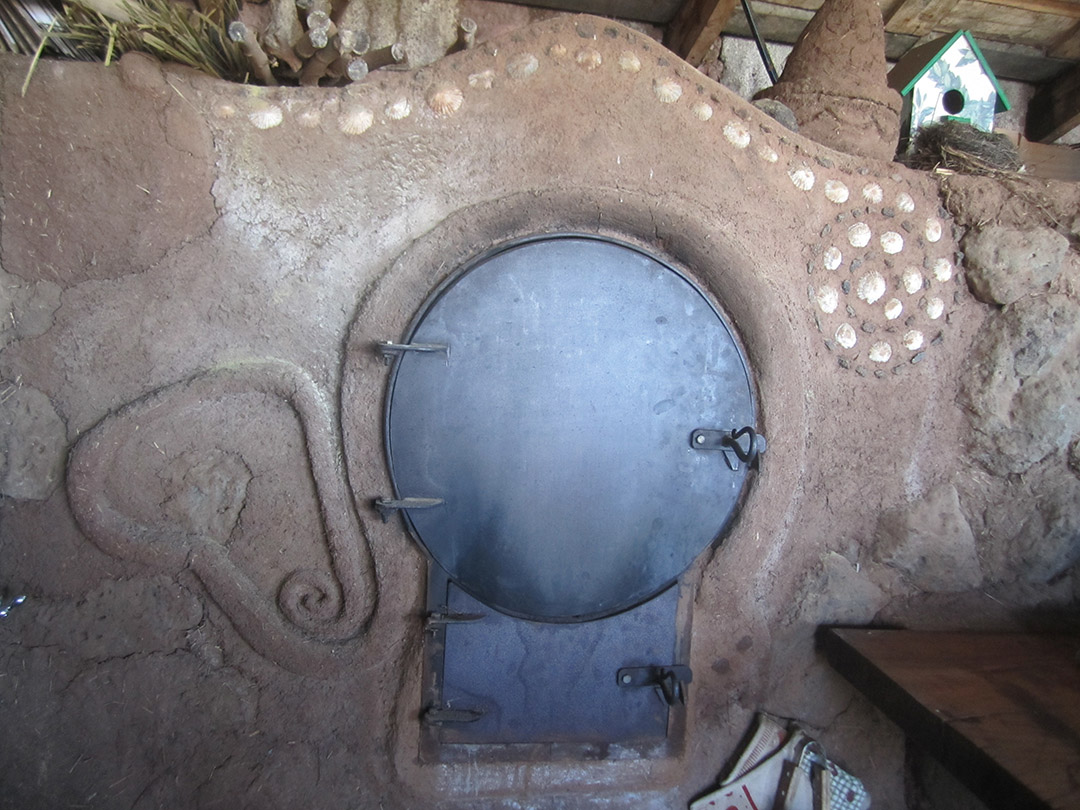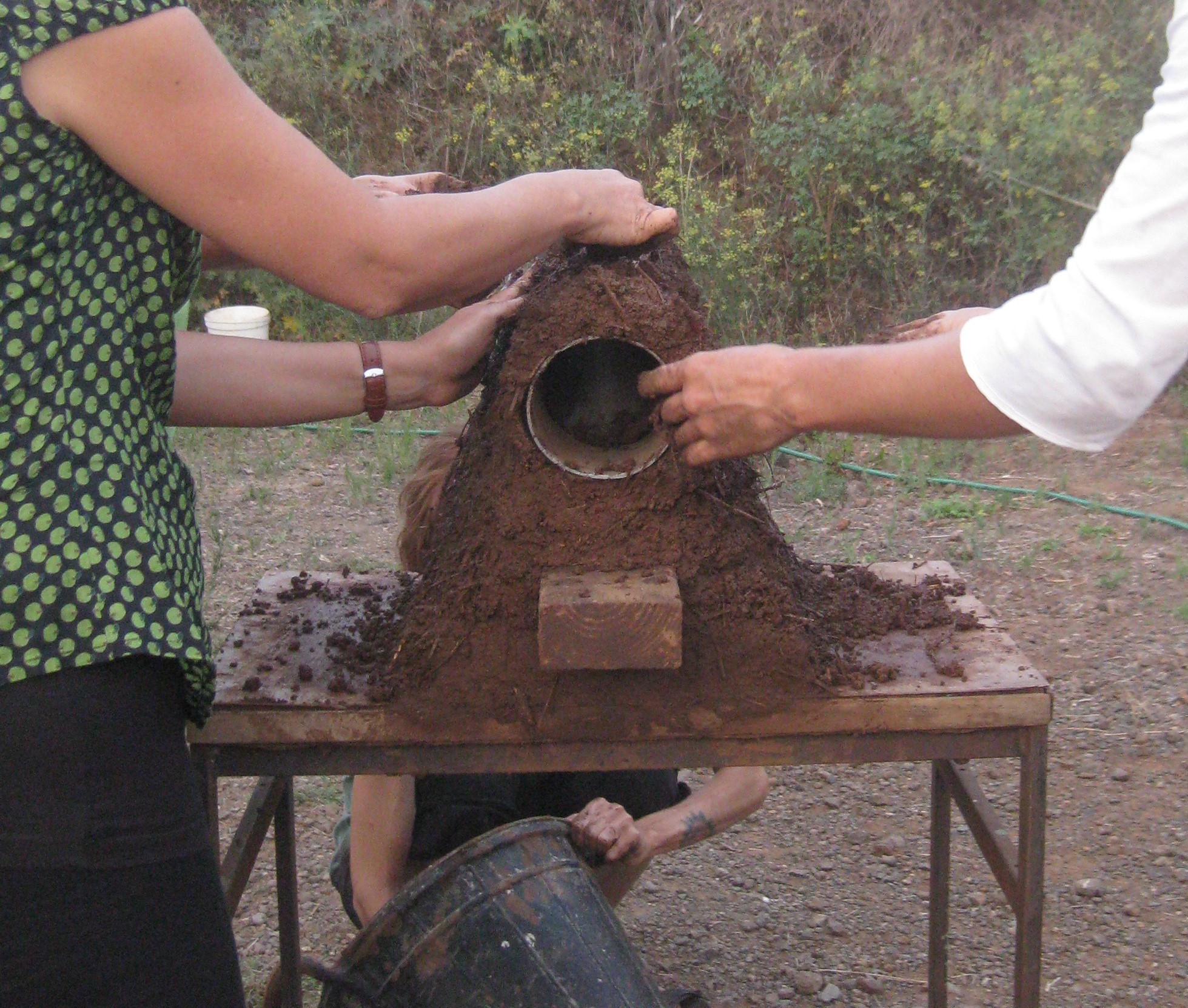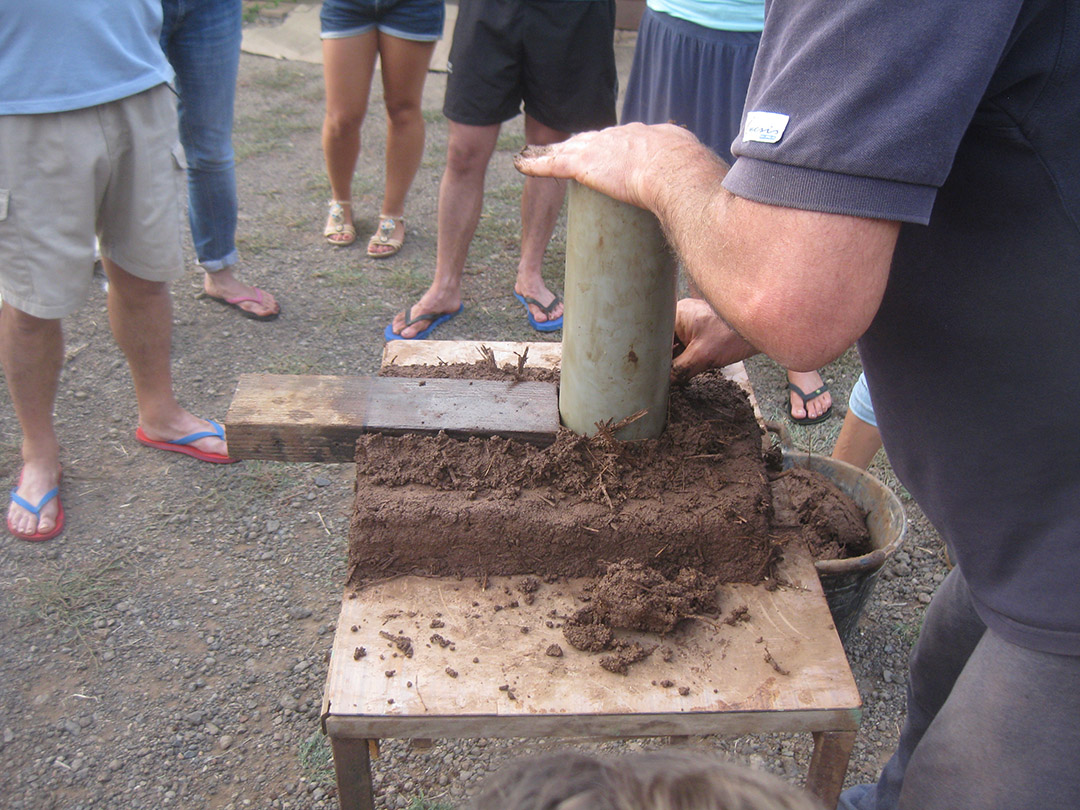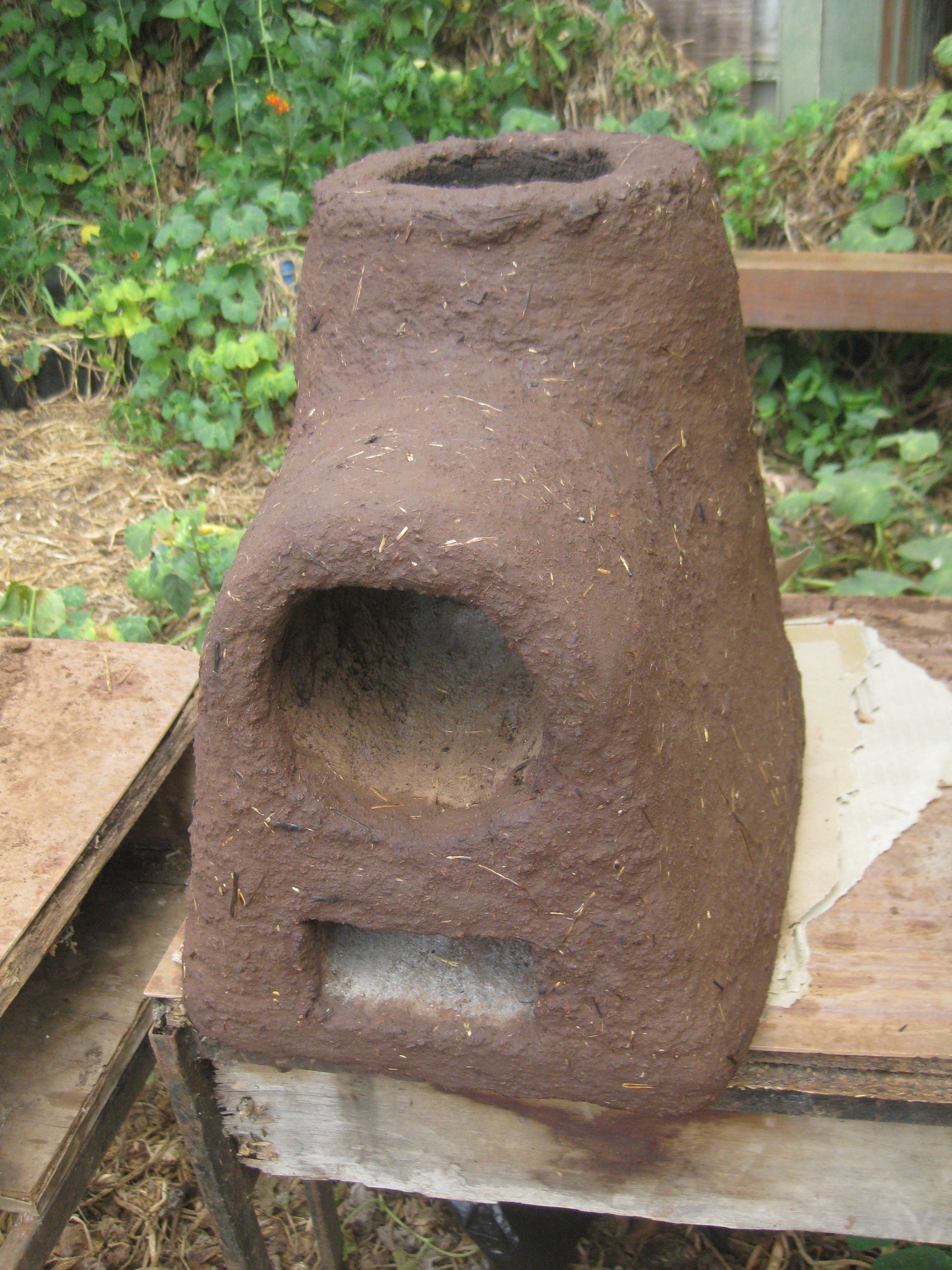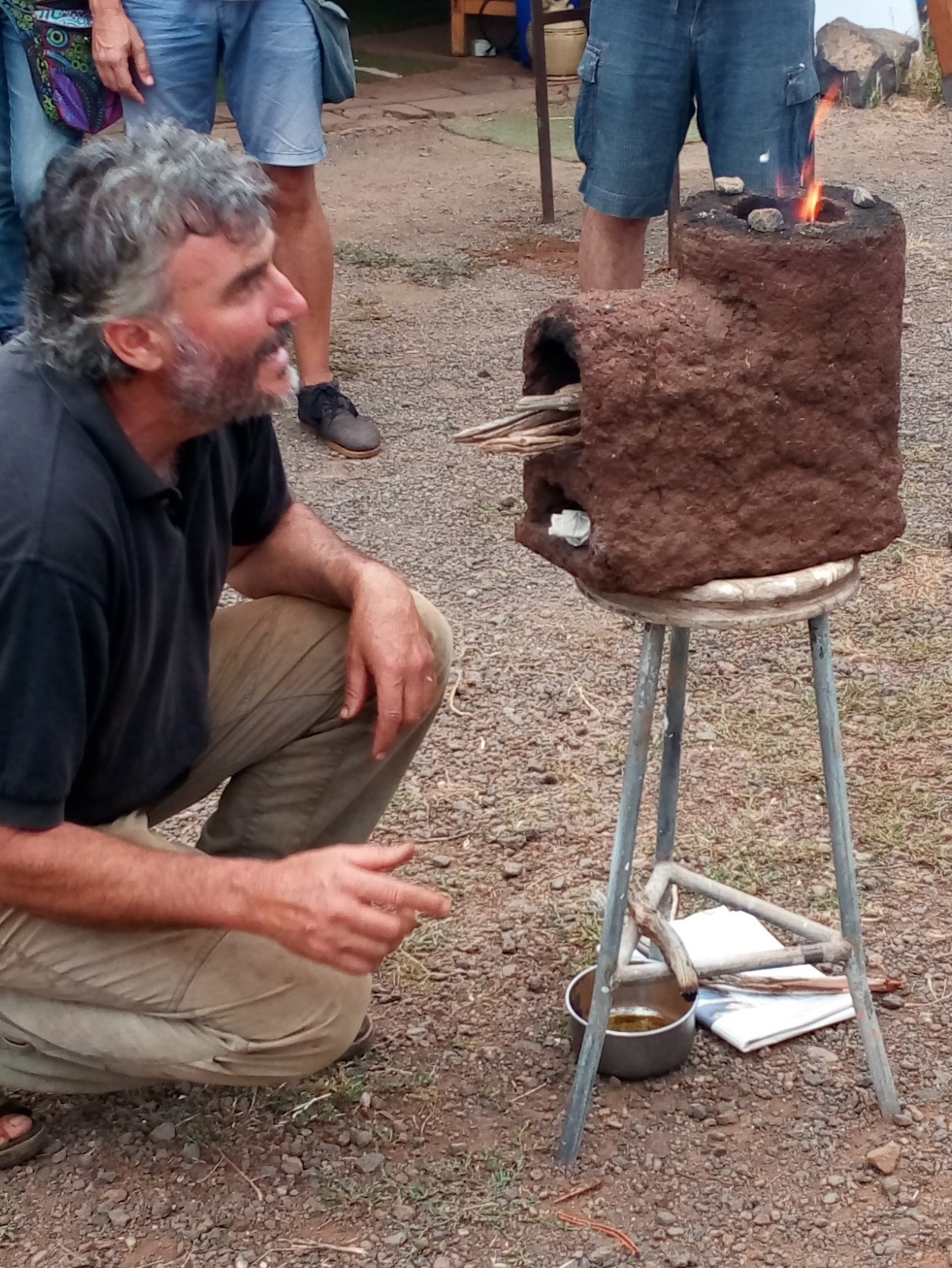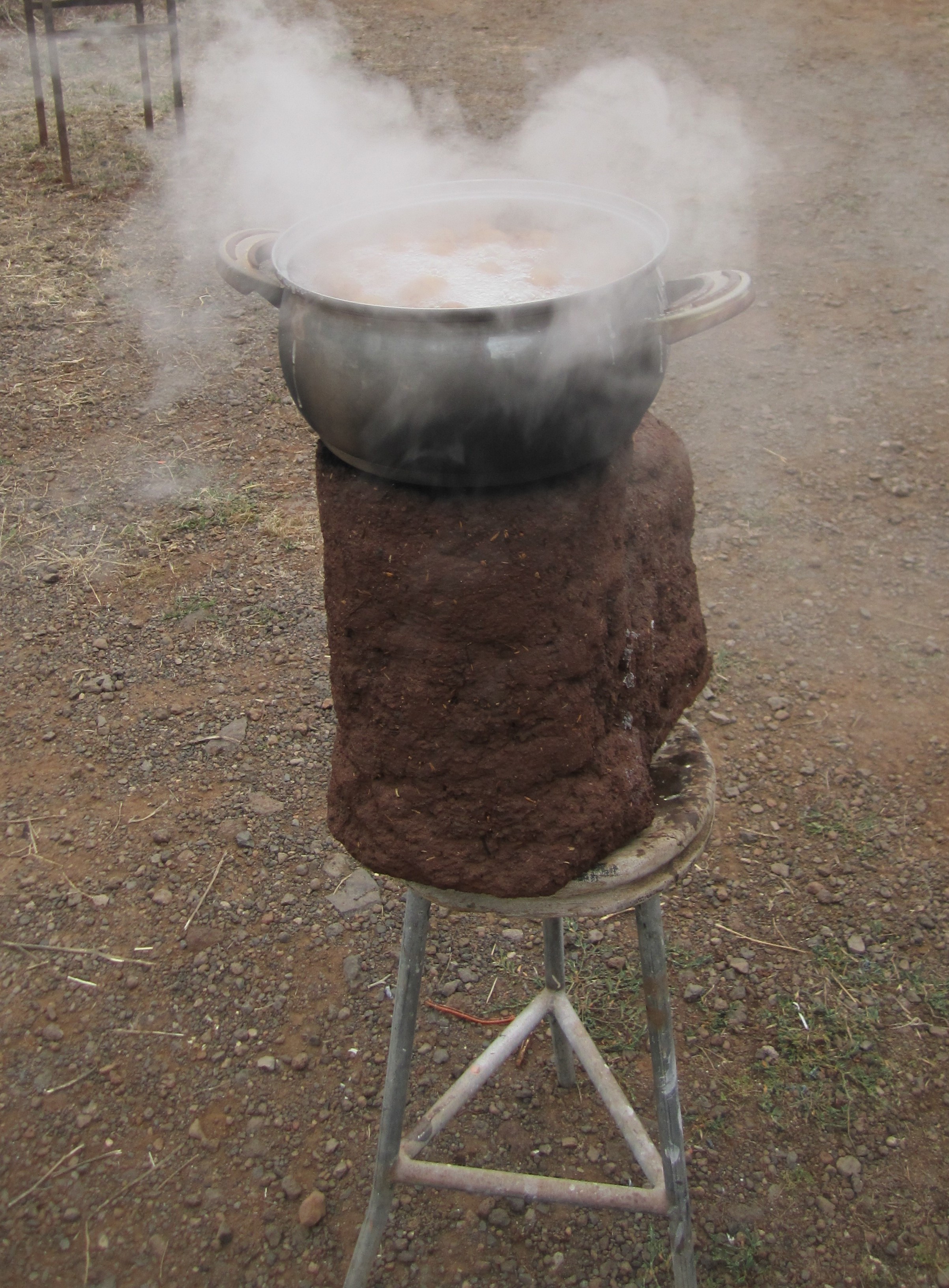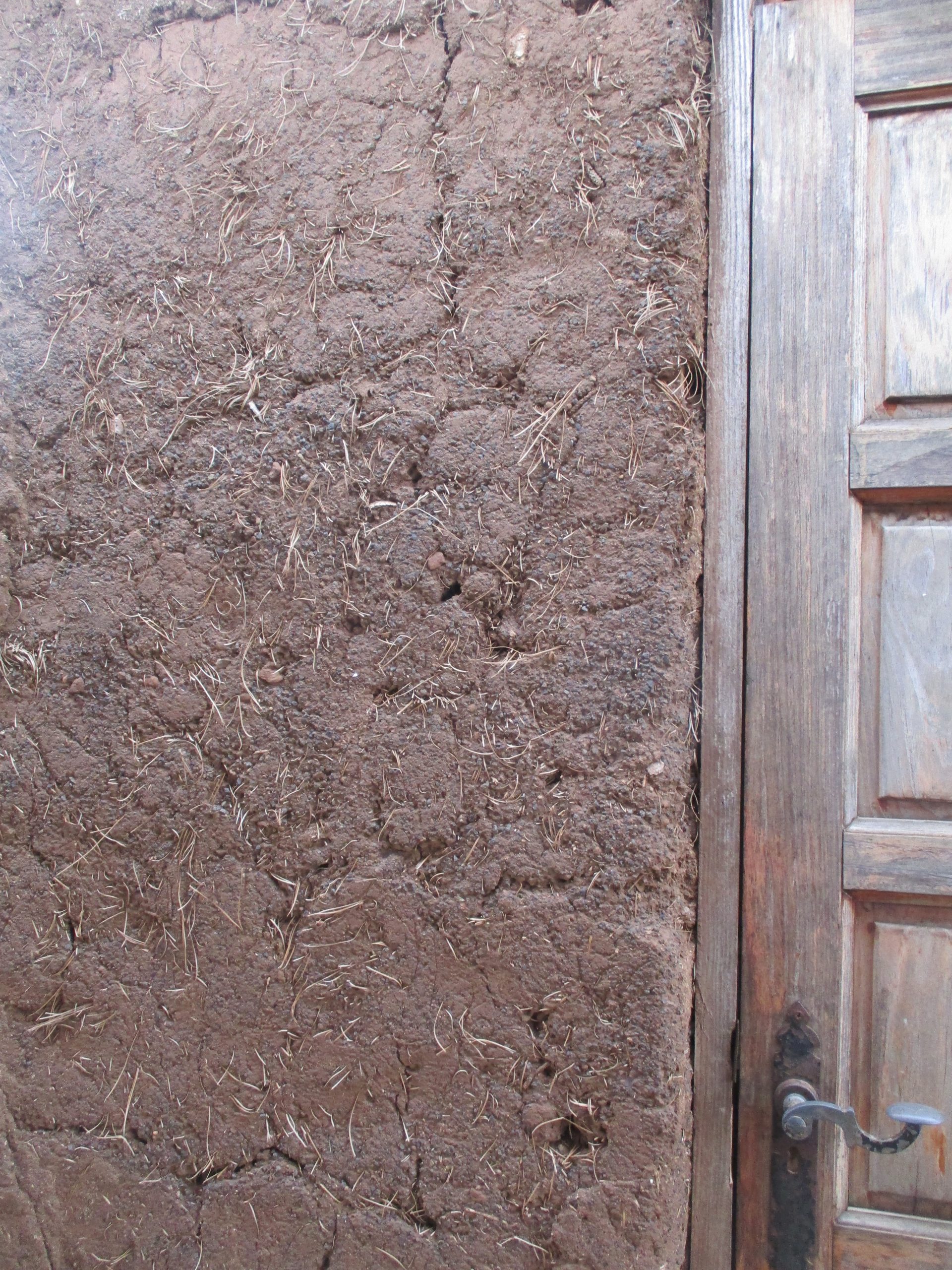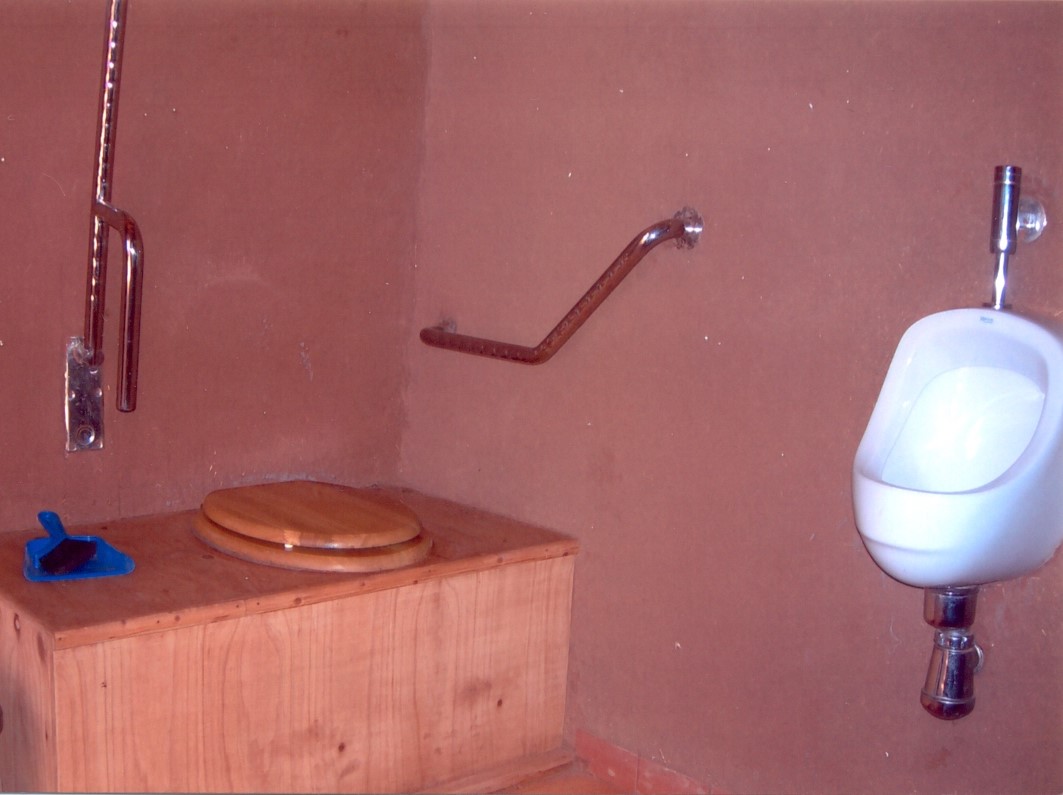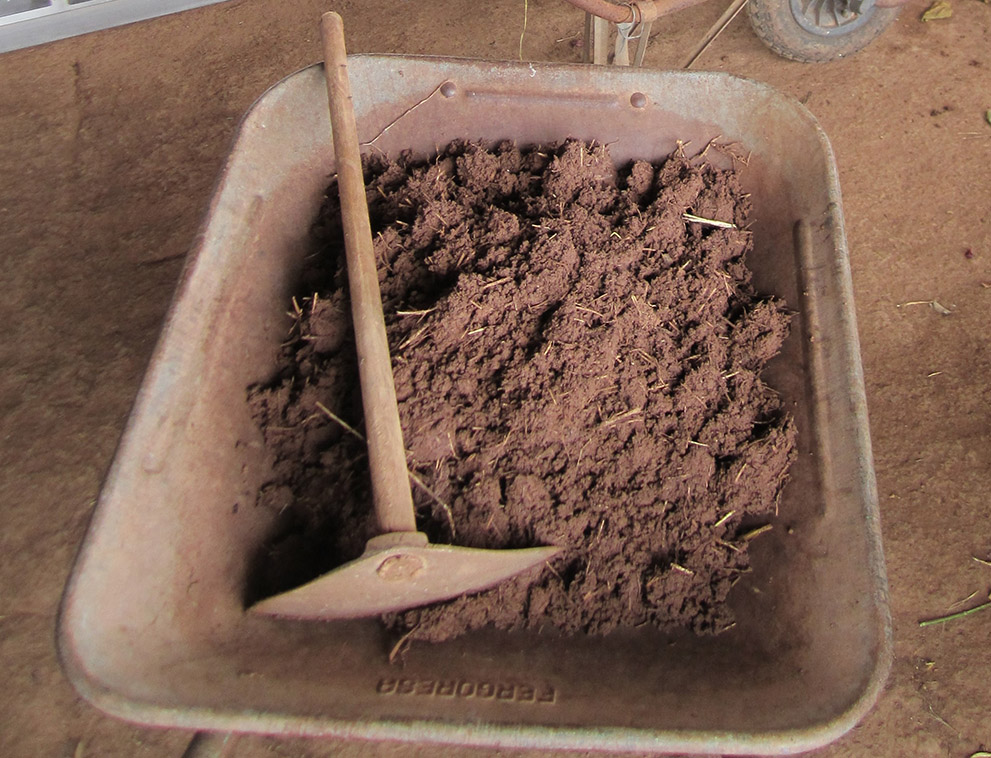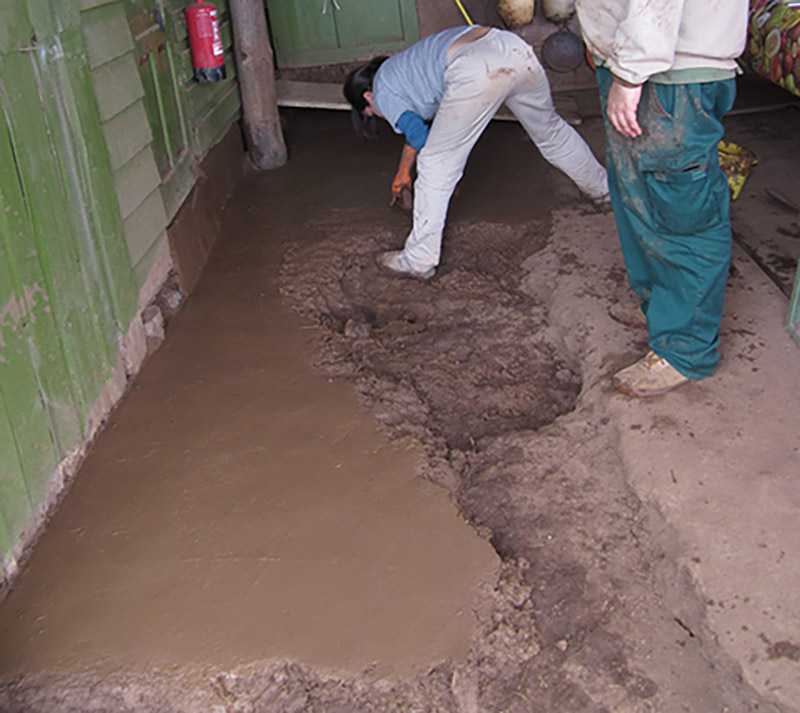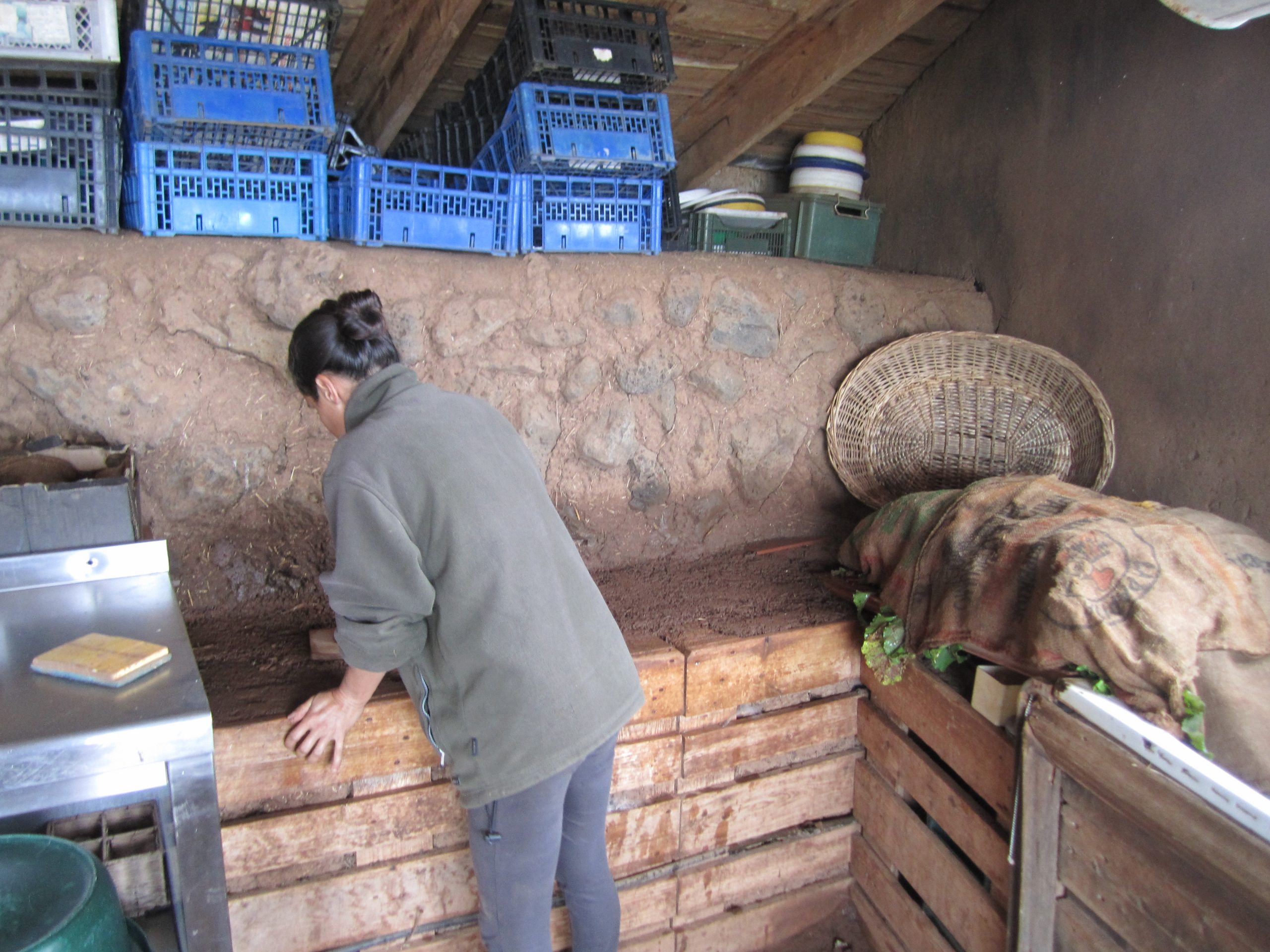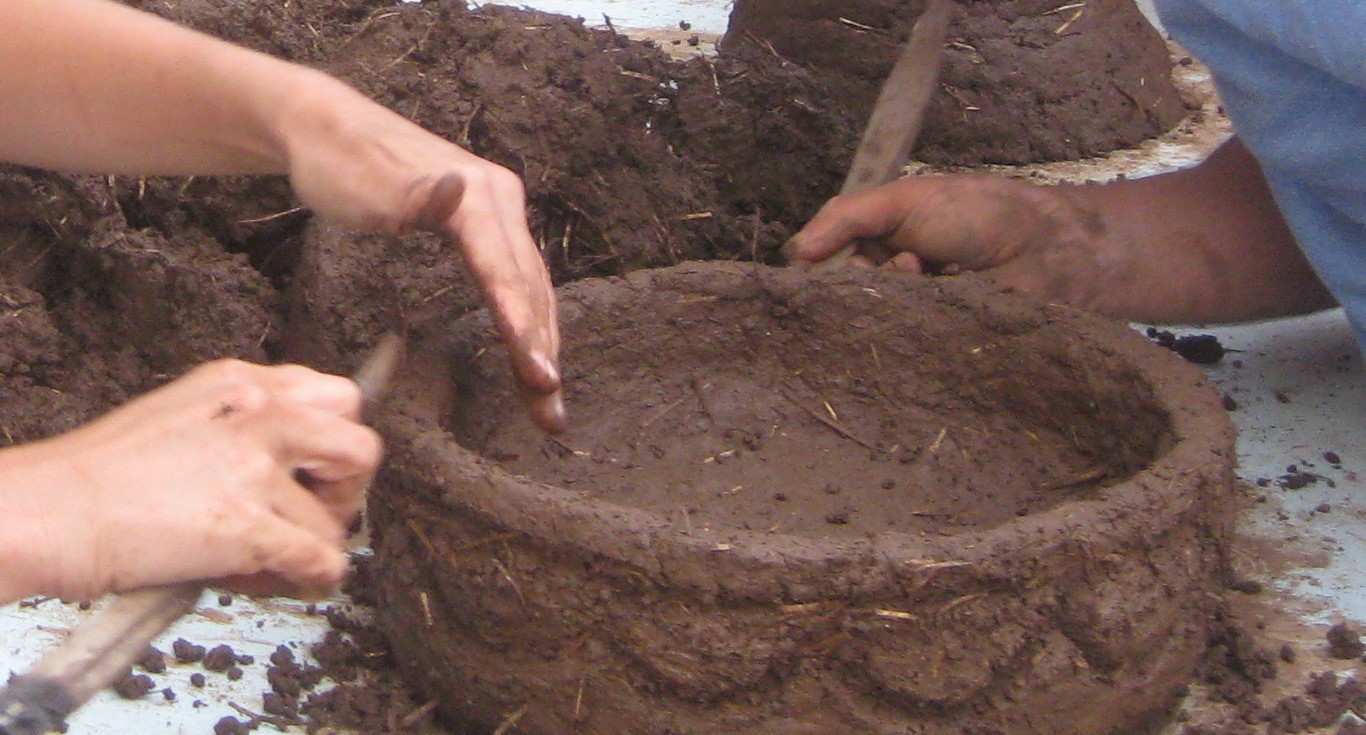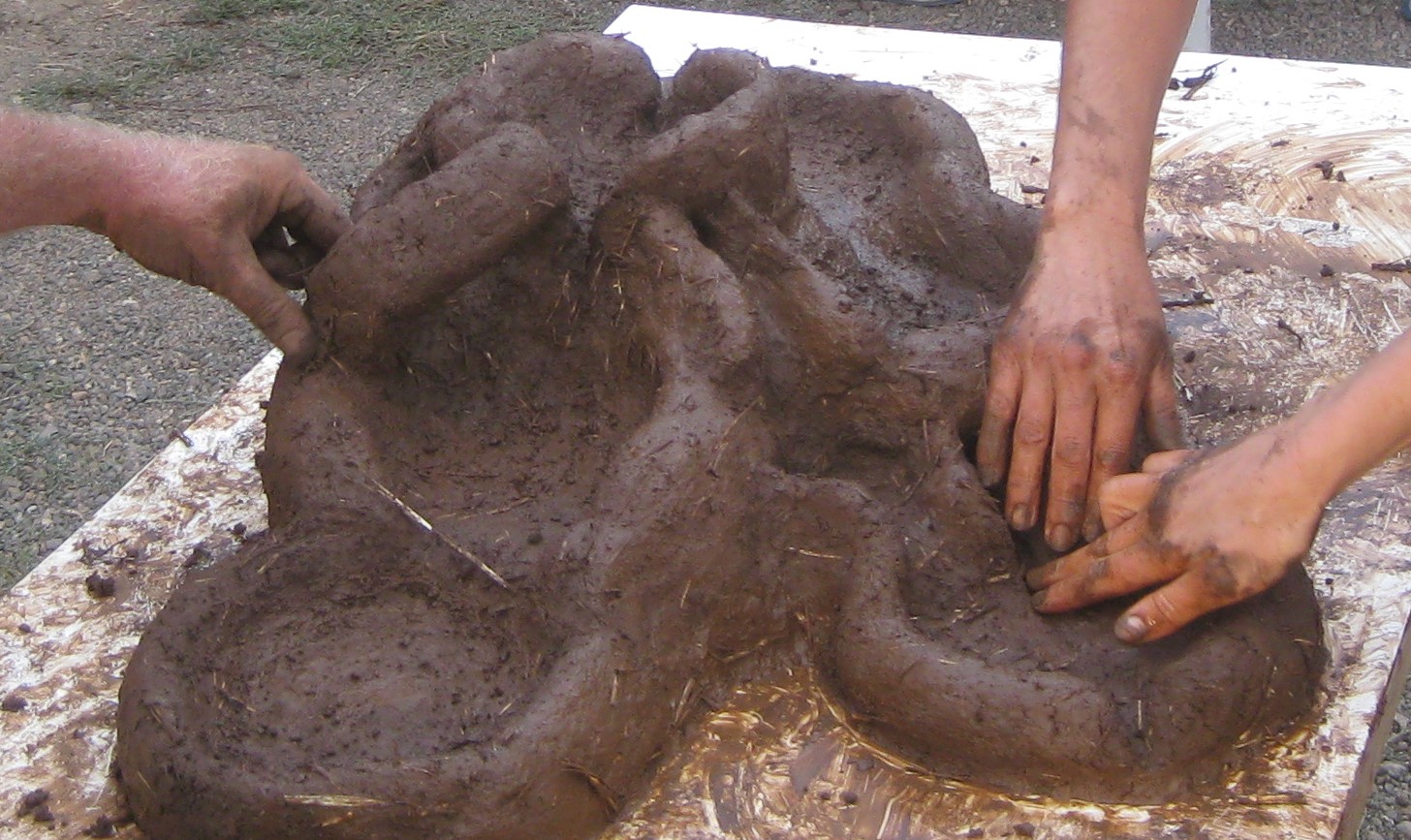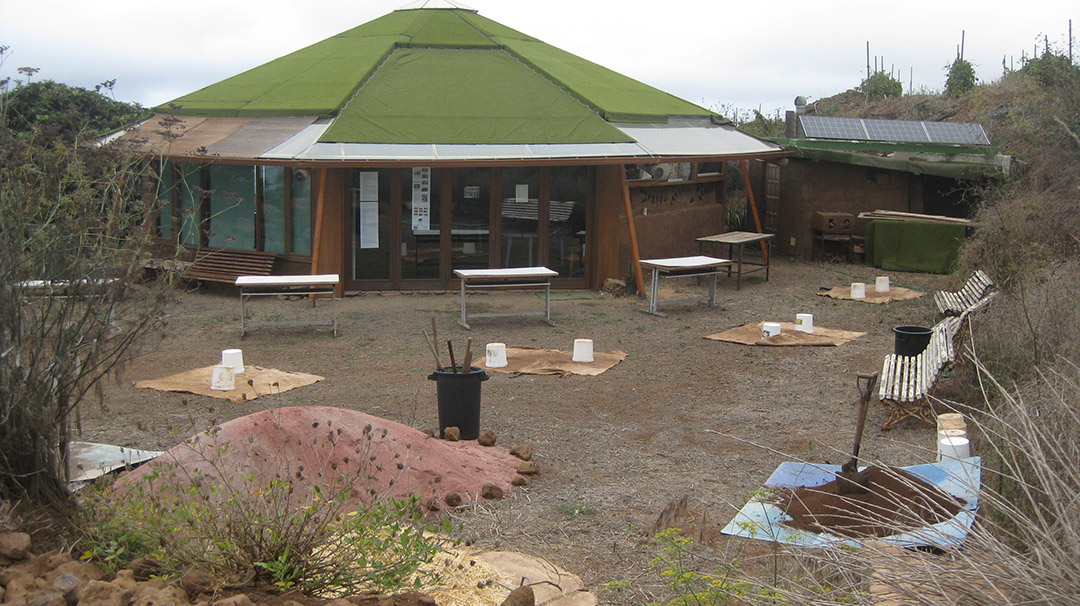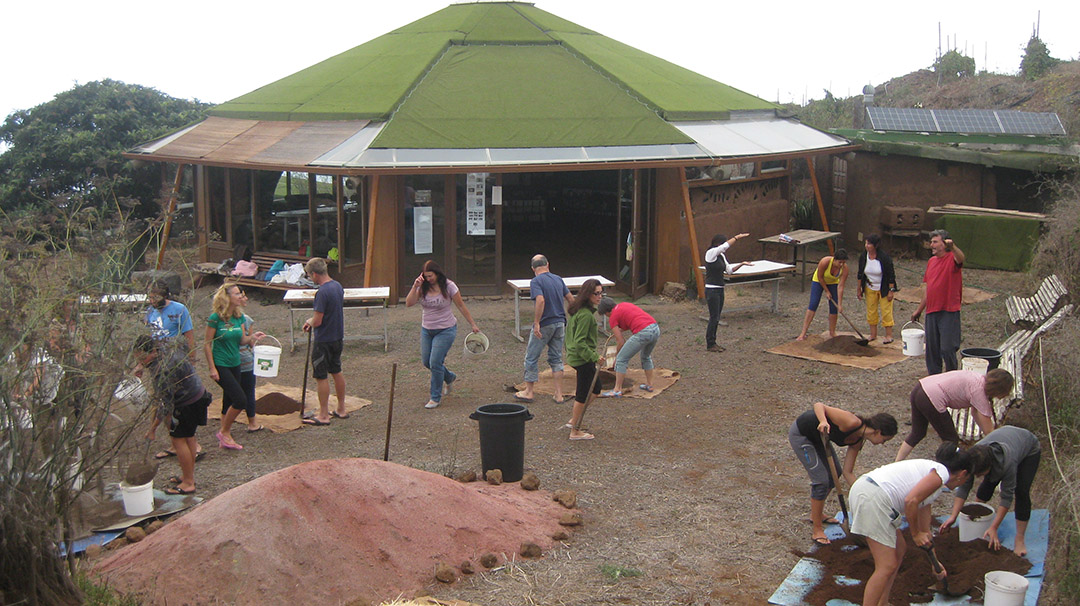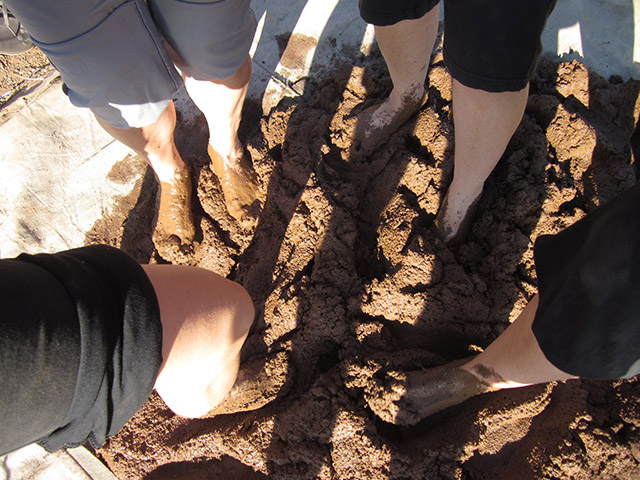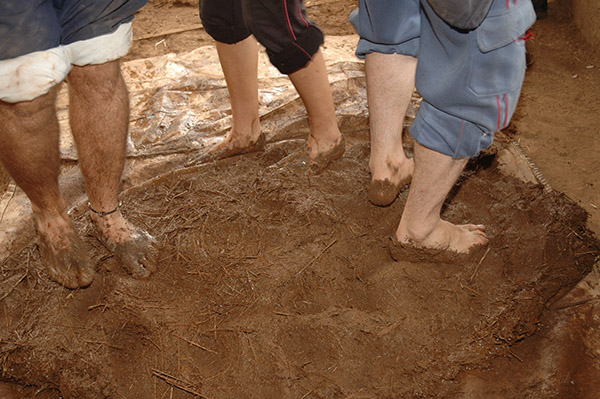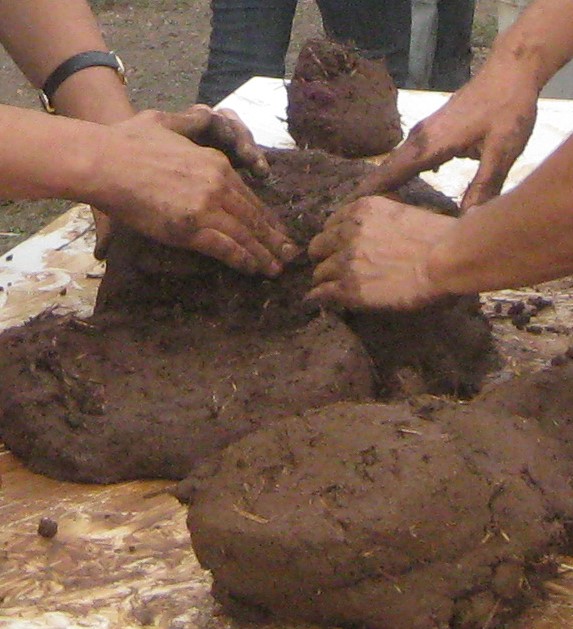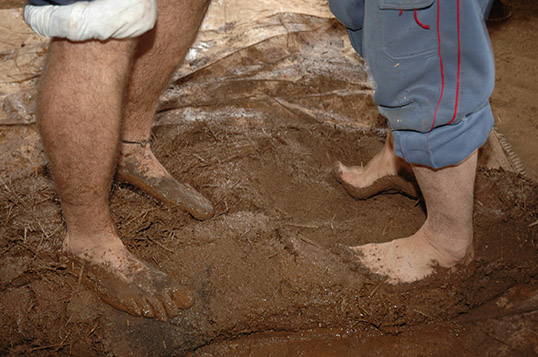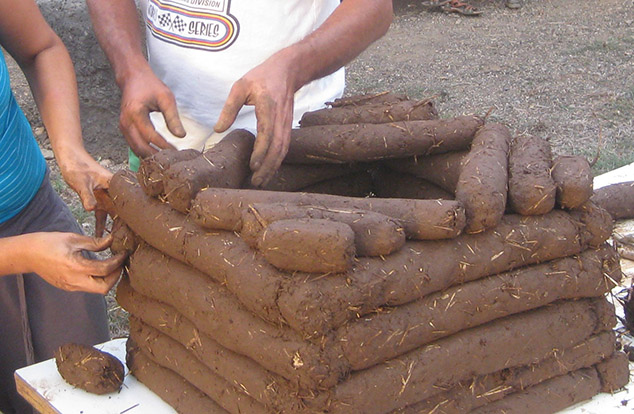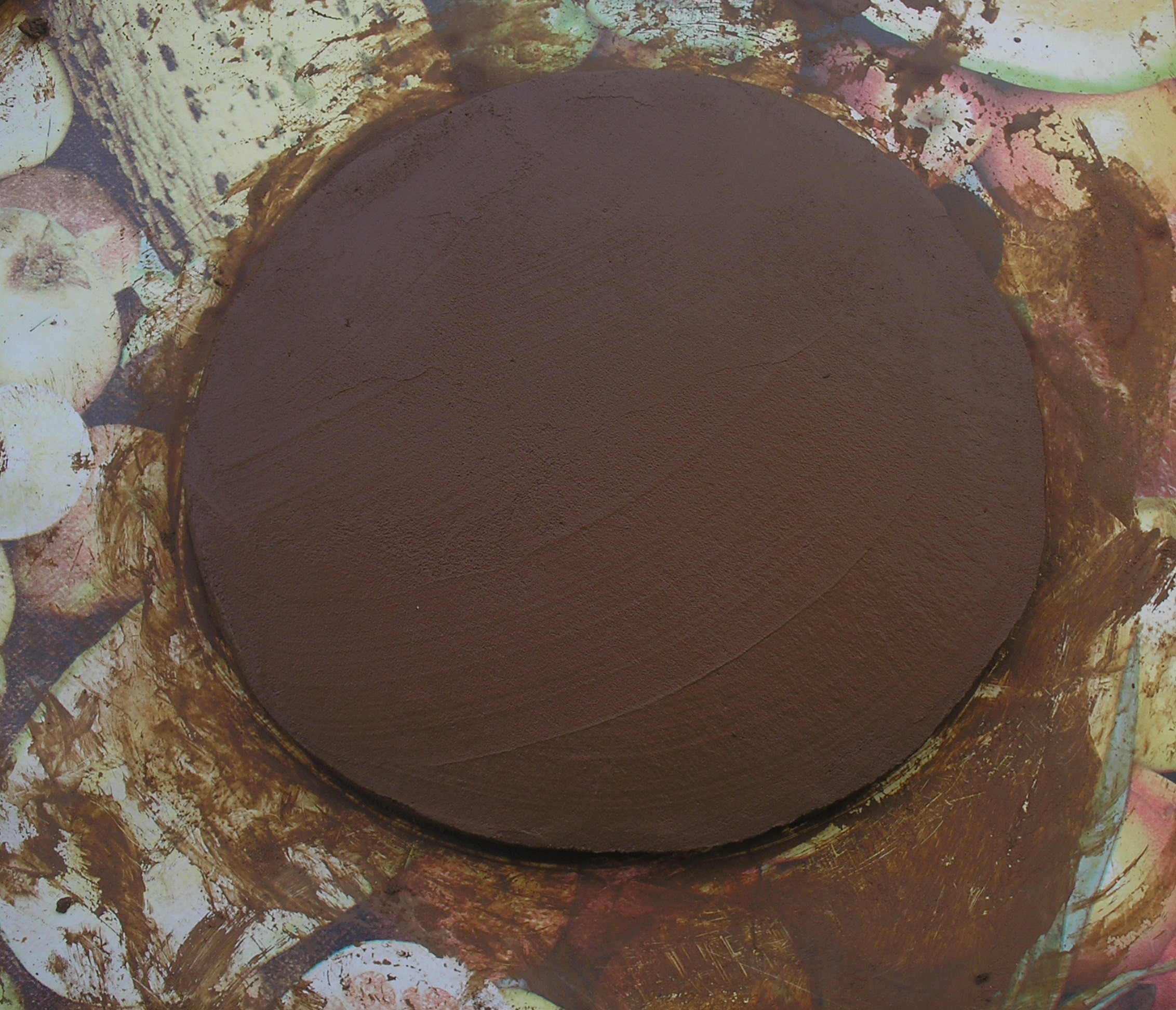
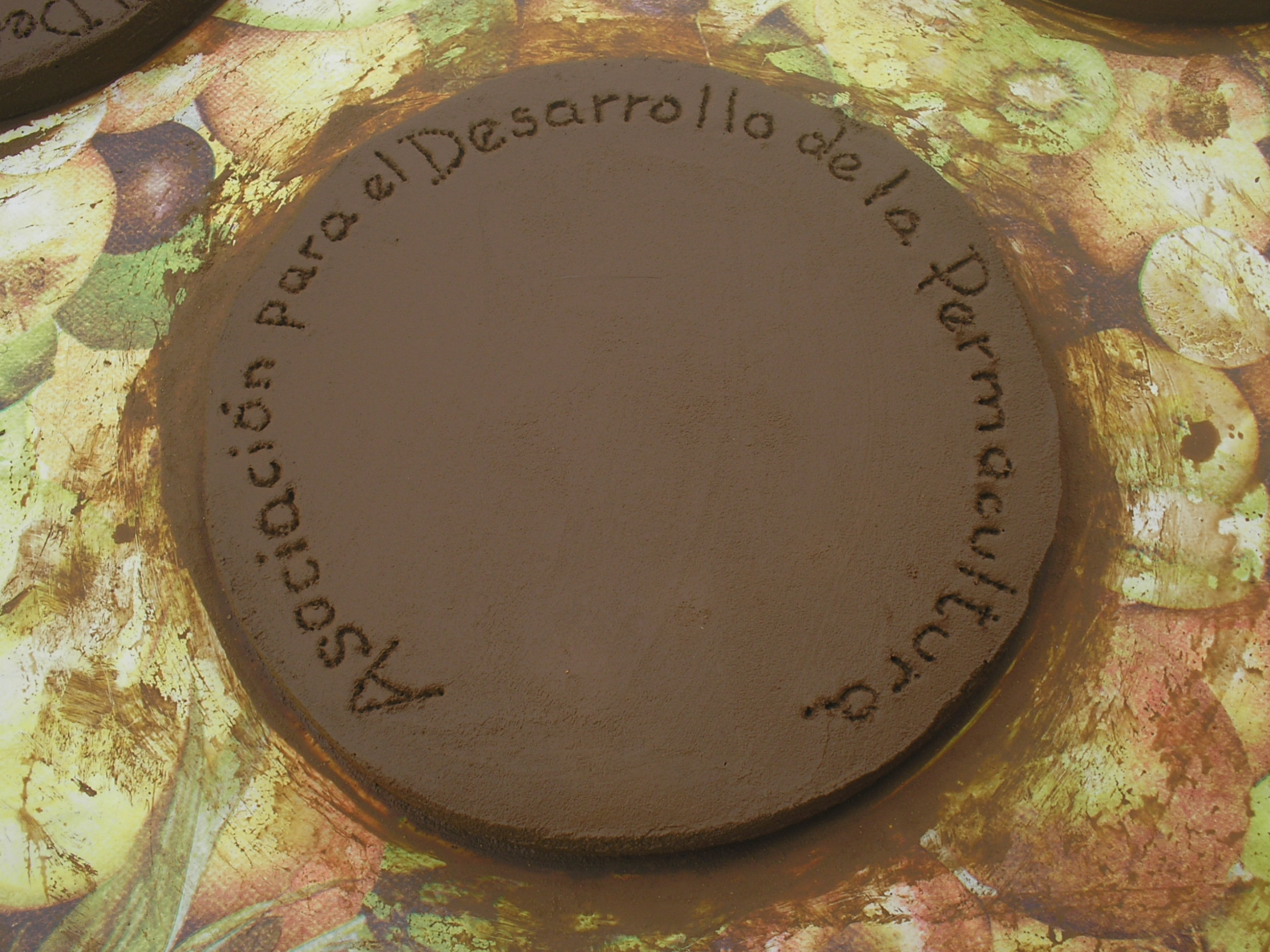
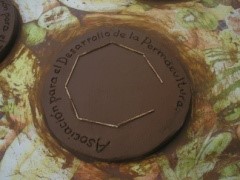
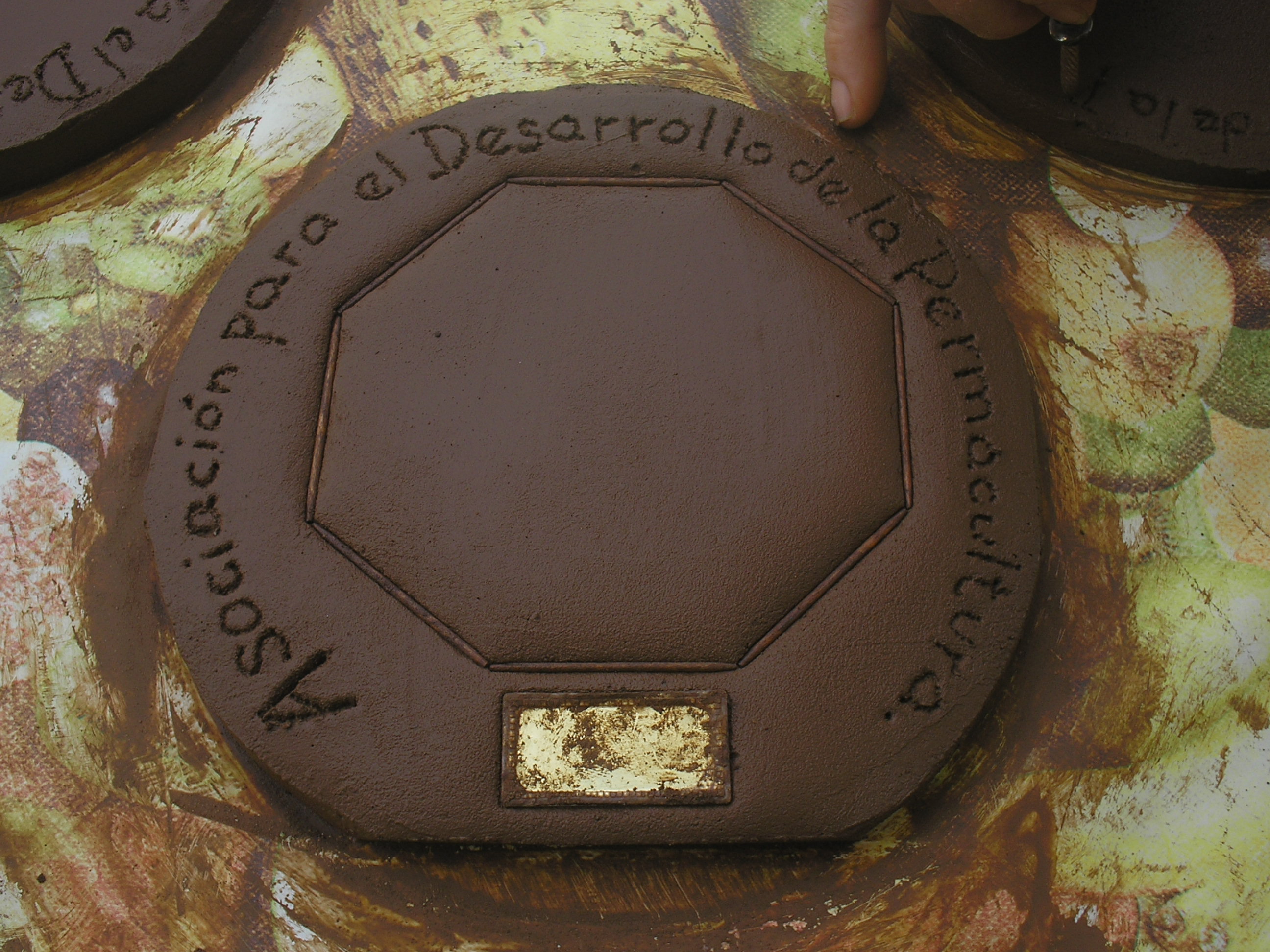
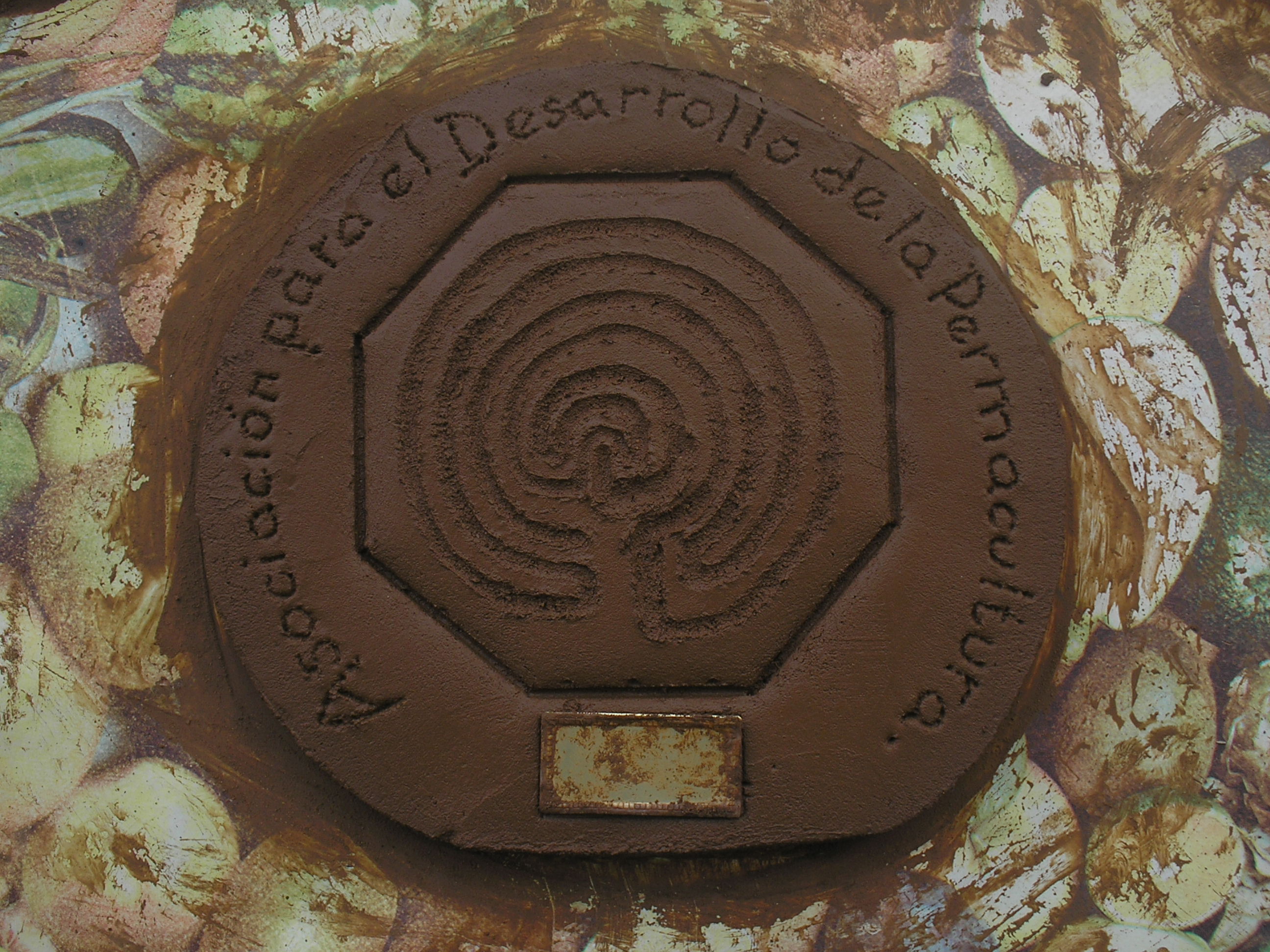
VII.1.- Mud as a form of therapy
In this didactic unit we want to share our experience in bioconstruction with mud. Stomping with our feet and building with our hands is an experience that benefits us therapeutically from the point of view of the psychic and physical dimension of health.
Different techniques are used when building with raw subsoil, being all of them very interesting, but in our case, we are going to discuss the Cob technique (Figure VII.1). With this technique, we also try to inspire the rescue of self-construction.
There are several advantages of building with mud: it balances the humidity of the air inside the building, it preserves an average temperature due to its thermal inertia, it is resistant to seismic activity, it is fireproof, natural buildings like these do not produce rubble, and it is the most efficient from the thermal point of view.
These advantages are to be considered, especially when comparing to the disadvantages of using cement, which is a highly used material for building that needs a lot of energy, it contaminates when manufactured, it produces pollution, it needs a lot of steel when building with it, a lot of paper for its packaging, and it produces loads of rubble.
The Cob technique was mainly developed in countries where it rains most of the year because once the mud mortar is prepared it is ready to be used directly on the construction without needing to create bricks which need a favourable time of the year in order to dry, and without needing much space outside as it occurs with the adobe technique. With the Cob technique, the mud is applied and dries on the construction itself.
We chose the Cob technique because we believe it is the most practical, easy and therapeutic of all the techniques. Practical since it is used directly on the construction, and thanks to the diverse possibilities of repairs, remodellings and new constructions. It is easy because of the noble materials used, and because it is simple to elaborate and handle. It is therapeutic because we do teamwork in a fun way by carrying out group dynamics with the students and by listening to music while we create the mud (Figure VII.2).
We also teach basic knowledge of old-fashioned constructions to the students in a more healthy and self-sufficient way, and by doing so we create a pleasant and different type of activity, encouraging teamwork, relationships among the students and team spirit; it also maintains the learners in the present moment by assuming responsibilities, such as paying attention in order to pour the correct measures in the mixtures. All this gives them a sense of fulfilment.
VII.2.- Noble materials for building
The materials we need in order to create the mud are: subsoil or clay, sand, plant fibre and water. It would be ideal to obtain all the materials from our area. The subsoil and sand deal with compaction whereas the fibre deals with traction, making the mixture three to four times stronger.
We can obtain the soil or clay from our own property by doing a small excavation and digging out the subsoil with help from the students of the course. The beneficiaries of the project will notice that underneath their feet, they’ve got a crucial material that can be used to build many things. We could also find subsoil in a construction site nearby.
It is necessary to sieve the subsoil in order to remove the stones it could contain, which allows us to work with our feet without getting hurt (Figure VII.3).
If we have built diversion channels for water management in our design, as we saw in the Didactic Unit II, the sand can be found after rain seasons in these channels, just after it ends and before the ditch starts. In this spot, some sand usually piles up when it’s raining. After it finishes raining we can organize activities with the group of students in order to collect sand in our property and then store it so we have it available when it is time to work with mud (Figure VII.4).
The plant fibres could be straw, pine needles, woodchips, etc. (Figure VII.5). We can cultivate them in our permacultural design. If this were the case, we can involve the beneficiaries of the project in the collecting and storing tasks of the plant fibres that we will later use for bioconstruction, the same way we did with the collection and storage of the subsoil, sand and gravel.
The proportions of the materials used in natural building are not standardized; there are no exact measures. Depending on the area, the subsoil could have more or less clay and sand, which means that it is necessary to conduct tests before starting to build so that our mud has the most accurate proportions as possible in the mixture that we will later use.
We can transform the tests to find out the necessary proportions and the appropriate conditions for its use into a group activity with the students.
The test consists of only mixing the subsoil with the sand, and creating at least three mud discs with different proportions. We can make the first disc, for example, with a ratio of one part subsoil to one part sand, the second disc with the same measure of subsoil but two parts sand, and the third disc with a ratio of two parts subsoil to one part sand.
We first mix the three dry measures of subsoil and sand in separate containers to make three discs; to each dry mixture we add water little by little until we obtain a dough that is not too watery. We shape the dough into a disc with a thickness of one finger (Figure VII.6). We number them from one to three and then we write down in a piece of paper the proportions of each test with the corresponding number of its disc. We then place the discs in a shaded place, sheltered against wind and humidity, hoping it will get well dry in a few days.
The disc that does not have any cracks or that has very few is the one we will use as reference, it is the disc that gives us the correct proportion of subsoil and sand, which we need in order to make our Cob mud.
If the three discs with the first proportions all have significant cracks, we would need to continue carrying out tests with different proportions until we obtain the disc that we can use as a reference.
We have experimented with a different model by using the trial and error method: we have exposed the discs to dry directly to the sun with the purpose of testing the material in a more extreme condition from the point of view of this activity. This experience has provided us with the knowledge that the disc that does not get any cracks has the ideal material proportions for a most resistant disc. This is something we learn by doing.
VII.3.- Getting our feet muddy
Once we have finished testing the proportions that we need of the materials we have, we will start the next activity, which consists of making the mud. In order to do this activity we need tools such as wheelbarrows, shovels, hoes, reused tarp and several buckets of the same size in order to match all the proportions (Figure VII.7).
The measures we provide in this unit of the PERMIND Training Guide are only for guidance. In our case, and with the materials we have available, the proportions of the disc that does not crack or hardly cracks are: 1 part subsoil, 1.5 part sand, 0.5 part straw, and 0.75 part water.
The final quantity of water depends on how humid the rest of the materials are, and, if they are humid, the mixture will already have water in it, which is important to take into account when adding more or less water. If this is the case, we recommend adding water little by little to avoid pouring too much and obtaining a watery mixture.
When it is time to start with the bioconstruction, we form groups of three to four people with the students of the course. It is the most ideal and balanced number of people that makes it easier to perform the different movements needed in this activity.
In order to work with this group and to produce the appropriate quantity of mud, we double the proportion of materials of the disc that does not crack or that hardly cracks. This is would be 2 parts subsoil, 3 parts sand, 1 part straw and 1.5 part water. We always use several same-size buckets as measurement tools.
We pour the different components on a piece of reused tarp of a minimum of 2 x 2 meters. We first pour the sand, followed by the subsoil on top, or the other way around. We mix both materials with a hoe until we obtain a uniform mixture; we pile it up and then carve a small depression in the centre, as if it were a crater of a volcano. Then, we add water little by little into the crater, while simultaneously mixing it into the uniform mix, until the mixture transforms into a mud paste (Figure VII.8).
Now the time has come for some foot therapy, where students and instructors start to take off their shoes and do group activities, such as dancing and singing to fun songs, or walking in circles while the mud is being kneaded therapeutically in order to shape it like a ”burrito”.
After we have been singing, dancing and stomping on the mud for a while, and there aren’t any remaining dry parts of the subsoil and sand mixture, two people of the group grab the tarp from opposite sides and pull it towards them in order to make the mixture rotate and form half a “burrito” with the paste; we then repeat the same process with the other side to complete the “burrito” in the centre of the reused tarp (Figure VII.9).
After the “burrito” has been created we stomp it again while another member of the group pours a bucket with the right proportion of straw over the mixture, using his hands in order to scatter it and trying to mix the straw well. We pour the straw little by little while we step on the mud and make new “burritos” until the right quantity of straw is added. We continue stepping on the mix and creating ”burritos” with the sides of the tarp until the straw is fully incorporated into the mixture. If we notice the mud has gotten too dry, we can splatter some water as we continue stepping until we obtain a uniform and flexible paste (Figure VII.10).
Figure VII.10.- Images of the foot therapy: adding plant fibre, stomping on the mix and creating ”burritos”
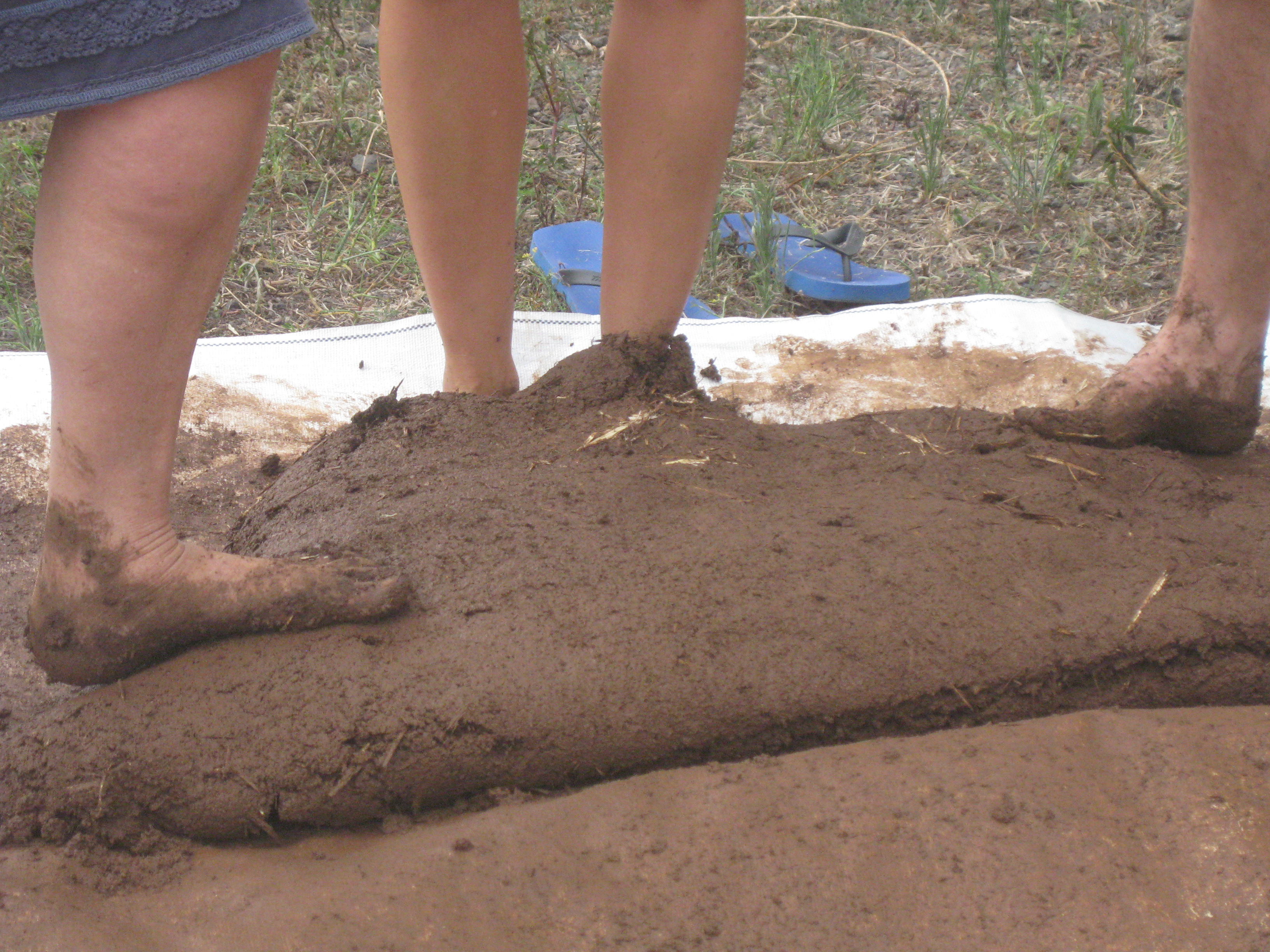
There is also the option, which we use, of starting not only by mixing the dry sand and subsoil, but also adding the dry straw to the mix from the beginning, mixing the different materials very well (Figure VII.11). Then we continue with the previously described process of adding water and creating “burritos”.
At this moment, the students need to carry out tests in order to make sure that the mud is completely ready for use. One of the tests is making a Cob mud ball with both hands until it is firm, we then drop it to the ground from shoulder height to see if it cracks or not. If it does not crack it means that we have got a good batch of mud that is ready to be used as building material.
We can also carry out the following test: with both hands we make a small and compact “burrito” with a diameter of about 3 to 4 centimetres, and a width of about 15 cm long; we grab it with one hand from one end leaving the rest of it hanging, and therefore checking if our mud is flexible and capable enough of resisting without breaking. If it stays as it is without breaking, it is ready to use (Figure VII.12). If it is split is that the mixture is not well trodden. In that case we would have to keep stepping on until the mud mix well..
Once we have used one of the tests to check if the mud is completely ready, we can use it to construct right away (Figure VII.13). We can also leave the mud to rest several days by covering it with humid sacks for later use, without deteriorating the batch. If we were to leave it longer time without using we just have to keep in mind that the mud shouldn’t get wet with the rain. The only thing that could happen is that it gets dry, but we can solve this problem by wetting and mixing the mud again when we need it.
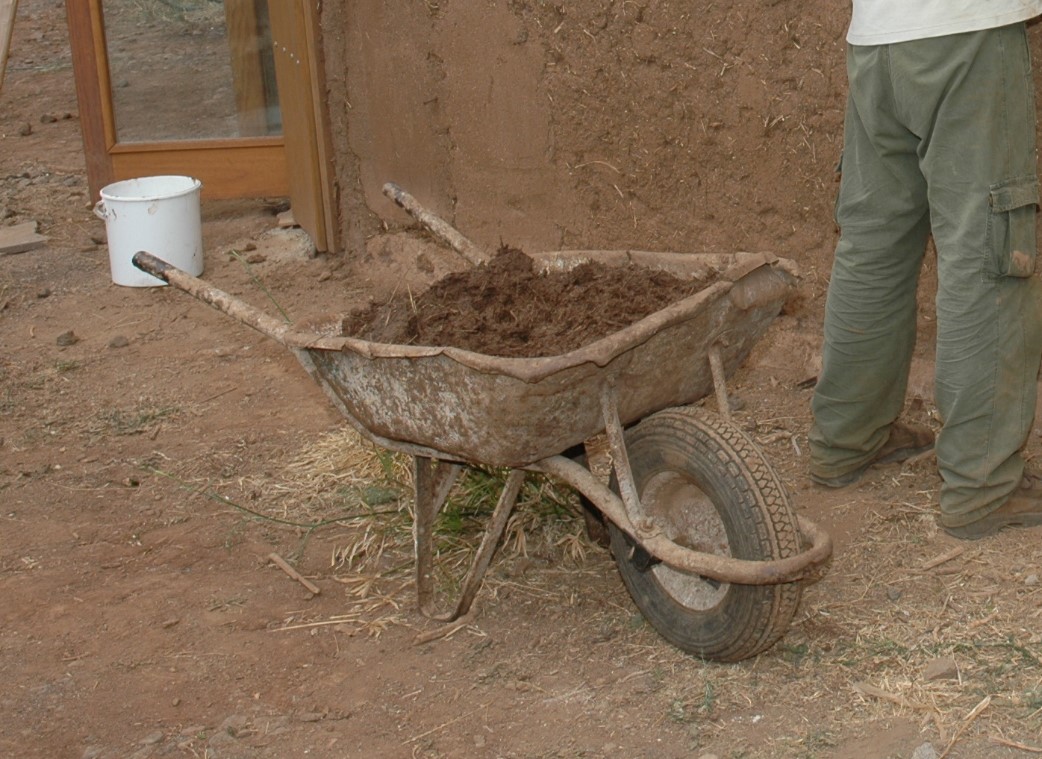
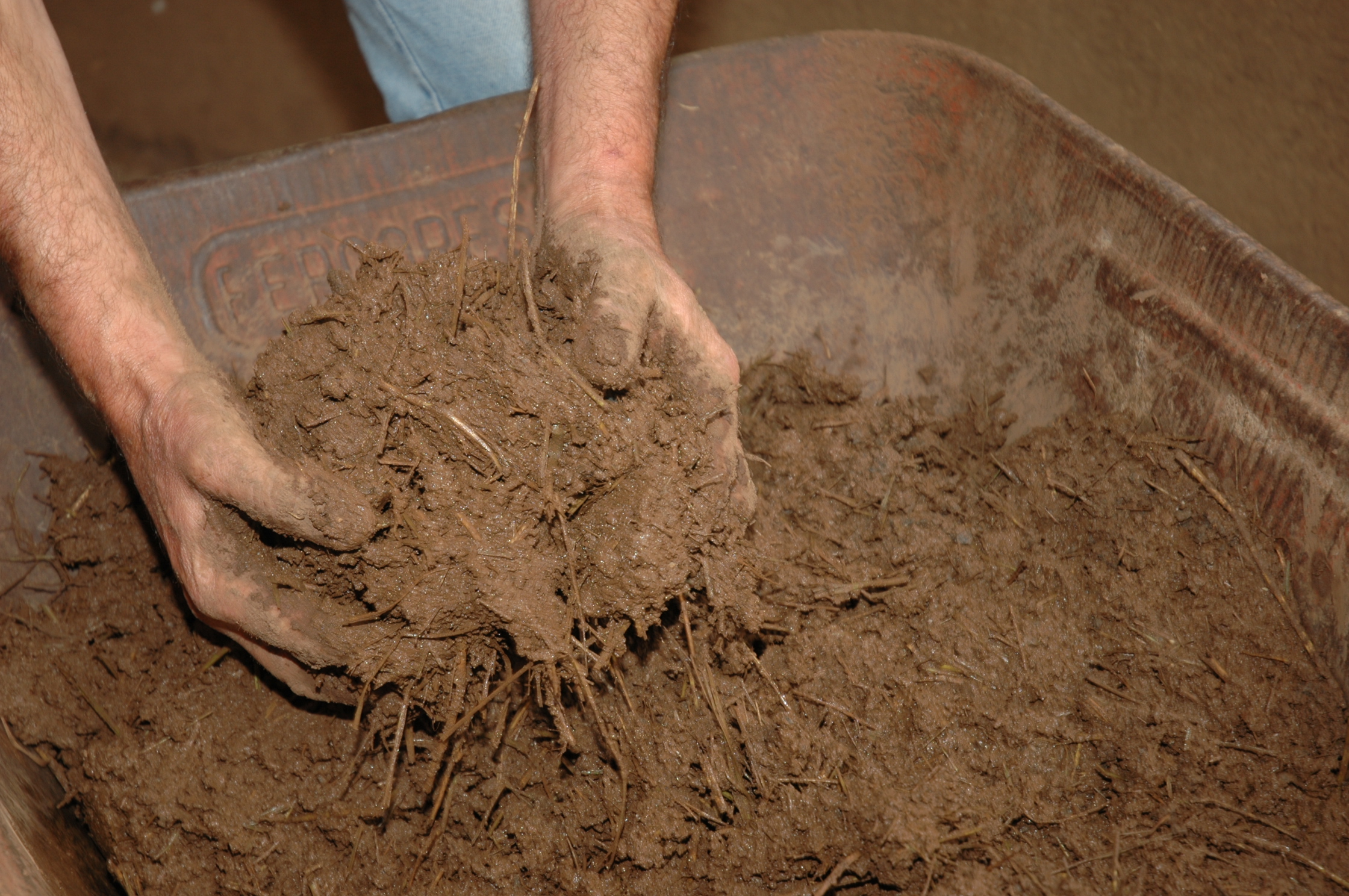
By the end of this activity we will have a very pleasant feeling of wellbeing in our feet and legs.
We do this therapeutic task barefoot on the tarp to avoid getting stones into the mixture with our feet. If we have to get off the tarp, we need to put on some kind of appropriate footwear, such as bathing slipper that we will take off when we get back into the mixture of the tarp. When we finish the activity, we will wash our feet using buckets of water we prepared previously (Figure VII.14)
VII.4.- Getting our hands dirty
We can use the mud that we have made in any construction or restoration project, for example, in big construction sites like houses, small sheds, bathrooms for a farm, markets to sell products of the farm, shelters for animals, etc. and also smaller constructions such as ovens or fireplaces, or to repair walls and floors, all kind of small restorations needed in the construction, sculptural details, built-in furniture, etc. (Figure VII.15).
Now it is time for some hand therapy, where the students and the instructors can prepare group or individual activities in order to transport the mud directly to the constructions or to projects that we need to build.
If we consider the walls of a house, bathroom or small shed, etc. we will suggest two ways of building them.
The first way is to construct without using any attachments or framework. In this case the walls need to be thicker, of about 50 cm if it is a load bearing wall, and of about 30 cm wide if it is a dividing wall. Therapeutically speaking it would be ideal to perform this task in groups of at least two persons, located on each side of the wall, who can grab the mud and shape it over the previously prepared foundation to create the wall. It is also possible to create a chain with more persons in order to transport the mud to the place where the wall is being built.
The persons that are constructing the wall – one at each side – will press on the mud with their fingers so it forms one dense whole. It is important to continue doing this until reaching an approximate height of 15 to 20 cm (Figure VII.16).
First, we construct the entire length of the wall at the same height. When we are finished, we will start again at the beginning, at this point the Cob mud has had time to air and can be covered by the next layer; we repeat the process again with the same thickness until we reach an approximate height of 40 to 50 cm, leaving a coarse layer at the top so the following layer can attach better when we continue the next day. At this stage of the process, we will stop working this wall for this day. We have to take into account that the height of the wall that we can build in one working day depends on how much water the mud contains.
It is important to not make the wall taller than the approximate height we recommend in order to avoid the mud wall from becoming uneven. Once we have reached a height of 40 to 50 cm, it is necessary to stop working on it until the next working day since the mud we have placed will have aired enough so the next layer can be added on top; we will repeat the same process adding the same height again, until after several days we complete the desired height of the wall.
If we had to build several walls, we could make more groups, guided by the instructors, that can add mud on all the walls without building them higher than the height we recommended before. This height depends on different factors: how watery our mud is, how sunny the day is, and especially how experienced the persons are getting by applying this technique.
Once we have finished building the walls, we can apply a thin layer as a finishing touch. In order to obtain the correct mixture, we first have to sieve all the materials (subsoil, sand and straw) using a sieve with finer meshes, and using the same ratios as when we made the mud. If we wanted to paint the walls, we would need breathable paints, such as lime wash paint so the mud doesn’t lose its breathing capacity.
The second way of building the walls is by using recycled woods such as pallets, boards, etc. which can be used as attachments or frameworks for the mud (Figure VII.17). We can carry out the task of collecting used materials with the beneficiary students of the course.
The attachment and framework task with wood can also be done with the students, starting with the carpentry where we can build all the walls with wood leaving spaces for the door and windows; we can also install the electricity by placing the cables inside the pallets or boards so that they get covered when the mud is added, marking on the outside where the light fittings, switches and outlets go. If it is a bathroom or kitchen, we also install the pipes in between the wood, also marking on the outside where the water comes out, and therefore making it all ready to add the mud.
We might need professionals to guide us through these tasks, or instructors to go through some training so that they can learn how to do them. In any case, the students can participate in these activities by doing the simplest tasks; being a part of the whole building process makes them have a sense of belonging that fulfils them (Figures VII.18 y VII.19).
When we are building the wall, we insert the mud with our hands in between the pieces of wood, covering completely all the pallets and boards on the inside and on the outside, and, if it were the case, we would also cover all the plumbing and electrical wires.
We can also install electricity and plumbing after we have added all the mud, leaving them in plain sight and then covering them with some kind of embellishments.
It is important to build eaves on outer mud walls to prevent them from getting wet in rainy seasons. If they didn’t have these eaves, we would have to protect the walls with lime wash, lime mortar or something similar so it would keeps its breathability. We also have to build wide plinths in case the rainwater splashes. We can solve this by installing gutters on the eaves to collect and store water (Figure VII.20).
Figure VII.20.- Bioclimatic classroom where we can notice the eaves with gutters that avoid splashes
We can integrate glass bottles of different colours in these mud walls as if they were stained glass windows. The students can make a creative design for the stained glass window on a piece of paper.
If the width of the wall is the same as the width of the bottles, we integrate them into the wall following the design guidelines (Figure VII.21).
Figure VII.21.- Detail of the stained glass with integrated bottles and building the stained glass wall
If the wall is wider than the bottles, we would need to cut them in order to integrate them into the wall. For this task, we need a table saw with a diamond blade and someone with experience or enough knowledge to be able to use it. If we do not have any of this available, a nearby workshop can take care of this job.
This process consists on collecting two identical bottles and cut them at the same level. To build the stained glass we only use the bottom of each bottle. We clean and dry thoroughly its interior and we attach both pieces to each other with an adhesive tape. The length of the combination of the two pieces must be the same as the width of the wall. This is important to take into account when cutting the bottles.
By doing so, we leave the bottom of one bottle at one side of the wall while the other bottom is on the other side, making it possible for the light to pass and creating a skylight effect without losing the green building insulation since the rest of the surface of both bottles is covered completely with mud (Figure VII.22).
We can also integrate slightly tilted bottles in the mud walls with the neck of the bottles pointing up so that they can function as hooks or coat hangers. In our case, we used them in the changing room of the people we work with, as they built the hangers themselves, they gave them a personal touch by decorating them with mud, which also created a sense of belonging (Figure VII.23).
There is also the possibility of building smaller projects, which doesn’t mean they are less important or less therapeutic, such as building a wood-fired oven made out of mud, since its insulation and heat retaining capacity makes it ideal to bake bread and cook all kinds of baked dishes (Figure VII.24)..
We can also build small energy-efficient wood-fired stove with mud, which are very practical since they do not need much firewood to cook food (Figures VII.25 y VII.26).
We can repair or restore mud walls that need plaster, or that are cracked or broken; we can use tools such as flat or normal trowels, mud mixers or sponges for these tasks (Figure VII.27). The students can use these tools on these small projects in a fun way, and acquire the skill of handling them by doing so.
Figure VII.27.- Images of walls made out of mud. Exterior to be repaired (left) and interior filled with plaster (right)
We can also build or repair floors; for this we need to compress the mud very well so it stays strong. Once it is dry we treat it with linseed oil to make it more sustainable (Figure VII.28).
We can incorporate art into each one of the bioconstruction activities. But we can also create workshops with the only purpose of building decorative sculptures or sculptures that can be used to cook with (Figure VII.29).
When we have made our Cob mud creation, we will have a very pleasant feeling of wellbeing in our hands, the same feeling we had after stomping the mud with our feet.
In this unit we have included the essential explanations in order to do bioconstruction projects with the students even though we do not have any previous experience with mud. We always recommend for the instructors to take courses or go to workshops in their area to learn and get more knowledge about natural building (Figure VII.30).
Our intention is to highlight all the usages and benefits that using mud can have in our way of cooking, working, sheltering or just simply living.
VII.5.- To summarize
The way we live in our planet should be coherent with nature: not only knowing how to eat in a healthy way without depleting natural resources, but also knowing how to live without damaging, contaminating and wasting energy unnecessarily.
Building with mud is a noble activity that gives us shelter, saves energy without destroying or contaminating, ensures our wellbeing, provides us with warm conditions by absorbing the humidity from our homes and workplaces, and solves health problems related to respiration and the skeletal system (Figure VII.31).
Without a doubt, the persons that benefit from mud therapy will have a sense of safety throughout the whole process since the best tool to work with mud are our hands. Undoubtedly, those persons will feel fulfilled when they can look back and enjoy what they have created (Figure VII.32).






